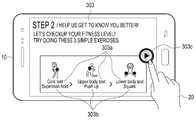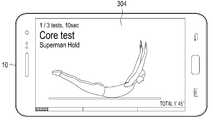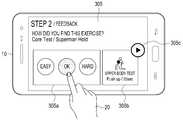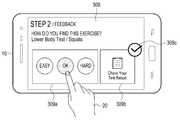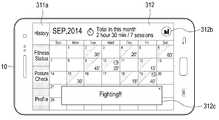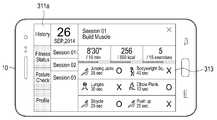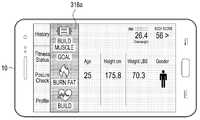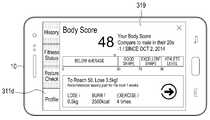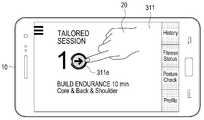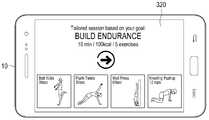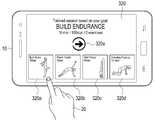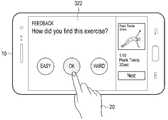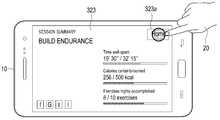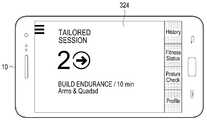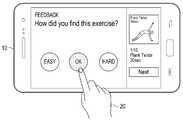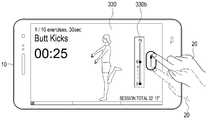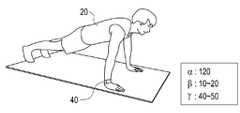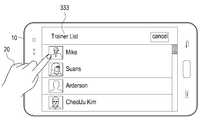KR20160084159A - Portable device and method for controlling thereof - Google Patents
Portable device and method for controlling thereofDownload PDFInfo
- Publication number
- KR20160084159A KR20160084159AKR1020150000717AKR20150000717AKR20160084159AKR 20160084159 AKR20160084159 AKR 20160084159AKR 1020150000717 AKR1020150000717 AKR 1020150000717AKR 20150000717 AKR20150000717 AKR 20150000717AKR 20160084159 AKR20160084159 AKR 20160084159A
- Authority
- KR
- South Korea
- Prior art keywords
- user
- motion
- image
- movement
- portable terminal
- Prior art date
- Legal status (The legal status is an assumption and is not a legal conclusion. Google has not performed a legal analysis and makes no representation as to the accuracy of the status listed.)
- Ceased
Links
Images
Classifications
- G—PHYSICS
- G09—EDUCATION; CRYPTOGRAPHY; DISPLAY; ADVERTISING; SEALS
- G09B—EDUCATIONAL OR DEMONSTRATION APPLIANCES; APPLIANCES FOR TEACHING, OR COMMUNICATING WITH, THE BLIND, DEAF OR MUTE; MODELS; PLANETARIA; GLOBES; MAPS; DIAGRAMS
- G09B5/00—Electrically-operated educational appliances
- G09B5/02—Electrically-operated educational appliances with visual presentation of the material to be studied, e.g. using film strip
- H—ELECTRICITY
- H04—ELECTRIC COMMUNICATION TECHNIQUE
- H04M—TELEPHONIC COMMUNICATION
- H04M1/00—Substation equipment, e.g. for use by subscribers
- H04M1/72—Mobile telephones; Cordless telephones, i.e. devices for establishing wireless links to base stations without route selection
- H04M1/724—User interfaces specially adapted for cordless or mobile telephones
- H04M1/72448—User interfaces specially adapted for cordless or mobile telephones with means for adapting the functionality of the device according to specific conditions
- H04M1/72563—
- G—PHYSICS
- G09—EDUCATION; CRYPTOGRAPHY; DISPLAY; ADVERTISING; SEALS
- G09B—EDUCATIONAL OR DEMONSTRATION APPLIANCES; APPLIANCES FOR TEACHING, OR COMMUNICATING WITH, THE BLIND, DEAF OR MUTE; MODELS; PLANETARIA; GLOBES; MAPS; DIAGRAMS
- G09B19/00—Teaching not covered by other main groups of this subclass
- G09B19/003—Repetitive work cycles; Sequence of movements
- G09B19/0038—Sports
- H—ELECTRICITY
- H04—ELECTRIC COMMUNICATION TECHNIQUE
- H04M—TELEPHONIC COMMUNICATION
- H04M1/00—Substation equipment, e.g. for use by subscribers
- H04M1/72—Mobile telephones; Cordless telephones, i.e. devices for establishing wireless links to base stations without route selection
- H04M1/724—User interfaces specially adapted for cordless or mobile telephones
- H04M1/72403—User interfaces specially adapted for cordless or mobile telephones with means for local support of applications that increase the functionality
- H04M1/72418—User interfaces specially adapted for cordless or mobile telephones with means for local support of applications that increase the functionality for supporting emergency services
- H04M1/72424—User interfaces specially adapted for cordless or mobile telephones with means for local support of applications that increase the functionality for supporting emergency services with manual activation of emergency-service functions
- H04M1/72541—
Landscapes
- Engineering & Computer Science (AREA)
- Business, Economics & Management (AREA)
- Theoretical Computer Science (AREA)
- Educational Administration (AREA)
- Educational Technology (AREA)
- General Physics & Mathematics (AREA)
- Physics & Mathematics (AREA)
- Entrepreneurship & Innovation (AREA)
- Emergency Management (AREA)
- Human Computer Interaction (AREA)
- Computer Networks & Wireless Communication (AREA)
- Signal Processing (AREA)
- User Interface Of Digital Computer (AREA)
Abstract
Translated fromKoreanDescription
Translated fromKorean본 발명은 휴대 단말 및 그 제어 방법에 관한 것이다.The present invention relates to a mobile terminal and a control method thereof.
최근, 스마트 폰과 같은 휴대 단말의 보급이 급속도로 이루어져, 이제는 완전한 1인 1디바이스의 시대로 접어들었다. 이는, 상기 휴대 단말이 상기 휴대 단말의 사용자의 일상 생활의 일 부분이 되었다는 것을 의미하며, 실제로, 상기 휴대 단말의 사용자 또한 상기 휴대 단말 없이는 일상 생활이 어렵다는 점을 인식하고 있다.In recent years, the spread of mobile terminals such as smart phones has been rapidly made, and now it is time for a complete 1-in-1 device. This means that the portable terminal has become a part of the daily life of the user of the portable terminal. In fact, the user of the portable terminal is also aware that daily life is difficult without the portable terminal.
이에 따라, 상기 휴대 단말에는 단지 전화 통화 기능 및/또는 인터넷 검색 기능을 넘어, 상기 사용자의 생활을 보다 편하게 해 줄 수 있는 다양한 기능/기능들, 예를 들어, 상기 사용자의 건강을 증진시켜 줄 수 있는 헬스 케어 프로그램과 같은 기능을 포함하고 있다. 상기 헬스 케어 프로그램(health care program)은, 예를 들어 트레이너의 동영상을 상기 휴대 단말을 통하여 사용자에게 제공하고, 상기 사용자는 상기 제공된 동영상을 참조로 올바른 자세로 운동할 수 있는 환경을 상기 사용자에게 제공하는 방식을 포함할 수 있다.Accordingly, the portable terminal is provided with various functions / functions that can make the user's life more convenient, for example, to improve the health of the user, beyond a phone call function and / It includes functions such as a healthcare program. The health care program provides a user with an environment in which a trainer's moving image can be exercised in a correct posture with reference to the provided moving image through the portable terminal, . ≪ / RTI >
그러나, 상술한 종래의 기술에 따른 헬스 케어 프로그램은, 상기 헬스 케어 프로그램을 이용하는 사용자의 신체 상태를 고려하지 않고, 상기 헬스 케어 프로그램을 이용하는 모든 사용자들에게 동일한 헬스 케어 프로그램이 제공된다는 문제점이 있다.However, the above-described conventional healthcare program has a problem in that the same healthcare program is provided to all users who use the healthcare program without considering the physical condition of the user who uses the healthcare program.
또한, 종래의 기술에 따른 헬스 케어 프로그램은, 상기 헬스 케어 프로그램에 포함된 각각의 운동 타입에 대한 상기 사용자의 피드백을 상기 사용자가 수동적으로 입력해야 한다는 문제점이 있다.In addition, the conventional healthcare program has a problem that the user must manually input the feedback of the user for each type of exercise included in the healthcare program.
또한, 종래의 기술에 따른 헬스 케어 프로그램은, 상기 사용자에 의하여 입력된 피드백을 실시간으로 반영하지 못하는 바, 상기 사용자의 운동 수행 능력에 따른 헬스 케어 프로그램의 난이도를 실시간으로 조절하여 사용자에게 제공하지 못한다는 문제점이 있다.In addition, the healthcare program according to the related art can not reflect the feedback inputted by the user in real time, so that the degree of difficulty of the healthcare program according to the exercise performance of the user can not be provided to the user in real time There is a problem.
본 발명은 상기와 같은 문제점을 해결하고자 안출된 것으로, 본 발명이 해결하고자 하는 기술적 과제는, 상기 헬스 케어 프로그램을 이용하는 사용자의 신체 상태를 반영하여 상기 사용자의 운동 수행 능력에 따른 적절한 운동 프로그램을 제공할 수 있는 휴대 단말 및 그 제어 방법을 제공하는 것이다.SUMMARY OF THE INVENTION The present invention has been made to solve the above-mentioned problems, and it is an object of the present invention to provide an exercise program, which reflects a physical condition of a user using the healthcare program, And a control method therefor.
본 발명의 해결하고자 하는 다른 기술적 과제는, 상기 사용자의 신체 일부에 착용된 웨어러블 디바이스와 본 발명의 다양한 실시예에 따른 휴대 단말과의 연동을 통하여 상기 헬스 케어 프로그램을 사용하는 사용자의 운동 자세를 상기 사용자가 실시간으로 확인할 수 있는 휴대 단말 및 그 제어 방법을 제공하는 것이다.According to another aspect of the present invention, there is provided a method for controlling a wearable device wearing a body part of a user and a portable terminal according to various embodiments of the present invention, And a control method for the mobile terminal.
본 발명의 해결하고자 하는 또 다른 기술적 과제는, 상기 운동 타입에 대한 상기 사용자의 피드백을 상기 웨어러블 디바이스를 통하여 자동적으로 판단할 수 있는 휴대 단말 및 그 제어 방법을 제공하는 것이다.It is another object of the present invention to provide a mobile terminal and a control method thereof that can automatically determine the user's feedback on the exercise type through the wearable device.
본 발명의 해결하고자 하는 또 다른 기술적 과제는, 상기 피드백을 기초로 판단된 상기 사용자의 운동 수행 능력에 따른 헬스 케어 프로그램의 난이도를 실시간으로 조절하여 상기 사용자에게 제공할 수 있는 휴대 단말 및 그 제어 방법을 제공하는 것이다.According to another aspect of the present invention, there is provided a mobile terminal capable of adjusting the difficulty level of a healthcare program according to the exercise performance of the user determined based on the feedback in real time, .
상술한 과제를 달성하기 위한 본 발명의 다양한 실시예에 따른 휴대 단말은, 사용자의 상태를 판단하기 위한 제1 영상을 제공하는 디스플레이 모듈 및 상기 디스플레이 모듈과 전기적으로 연결되는 제어 모듈을 포함하고, 상기 제어 모듈은, 상기 제1 영상에 대한 상기 사용자의 응답 정보를 기초로 상기 사용자의 상태를 판단할 수 있다.According to another aspect of the present invention, there is provided a portable terminal including a display module for providing a first image for determining a status of a user and a control module electrically connected to the display module, The control module may determine the state of the user based on the response information of the user to the first image.
상술한 과제를 달성하기 위한 본 발명의 다양한 실시예에 따른 휴대 단말의 제어 방법은, 사용자의 상태를 판단하기 위한 제1 영상을 상기 사용자에게 제공하는 동작, 상기 제1 영상에 대한 상기 사용자의 응답 정보를 수신하는 동작 및 상기 수신된 응답 정보를 기초로 상기 사용자의 상태를 판단하는 동작을 포함할 수 있다.According to another aspect of the present invention, there is provided a method of controlling a mobile terminal, the method comprising: providing a first image to a user for determining a status of a user; An operation of receiving the information and an operation of determining the state of the user based on the received response information.
상기와 같은 본 발명에 따르면, 상기 휴대 단말을 통하여, 상기 헬스 케어 프로그램을 이용하는 사용자의 신체 상태를 반영하여 상기 사용자의 운동 수행 능력에 따른 적절한 운동 프로그램을 제공할 수 있는 효과가 있다.According to the present invention, it is possible to provide an appropriate exercise program according to the exercise performance of the user through the portable terminal, reflecting the physical condition of the user using the healthcare program.
또한, 상기와 같은 본 발명에 따르면, 상기 사용자의 신체 일부에 착용된 웨어러블 디바이스와 본 발명의 다양한 실시예에 따른 휴대 단말과의 연동을 통하여 상기 헬스 케어 프로그램을 사용하는 사용자의 운동 자세를 상기 사용자가 상기 휴대 단말 및/또는 상기 웨어러블 디바이스를 통하여 실시간으로 확인할 수 있는 효과가 있다.In addition, according to the present invention, the wearable device worn on a part of the body of the user and the portable terminal according to various embodiments of the present invention are interlocked with the user's exercise posture of the user using the healthcare program, Can be confirmed in real time via the portable terminal and / or the wearable device.
또한, 상기와 같은 본 발명에 따르면, 상기 휴대 단말이 상기 운동 타입에 대한 상기 사용자의 피드백을 상기 웨어러블 디바이스를 통하여 자동적으로 판단할 수 있는 효과가 있다.In addition, according to the present invention, the mobile terminal can automatically determine the user's feedback on the exercise type through the wearable device.
본 발명의 해결하고자 하는 또 다른 기술적 과제는, 상기 휴대 단말을 통하여, 상기 피드백을 기초로 판단된 상기 사용자의 운동 수행 능력에 따른 헬스 케어 프로그램의 난이도를 실시간으로 조절하여 상기 사용자에게 제공할 수 있는 효과가 있다.According to another aspect of the present invention, there is provided a method for controlling a healthcare program, the method comprising the steps of: It is effective.
본 발명의 효과는 상기 기술된 효과로 제한되지 아니하며, 다양한 효과가 본 명세서 상에 내재되어 있음은 통상의 기술자에게 자명하다.It should be apparent to those skilled in the art that the effects of the present invention are not limited to the effects described above, and that various effects are inherent in the disclosure.
도 1a는 본 발명의 다양한 실시예에 따른 휴대 단말의 블록도를 예시적으로 도시한 도면이다.
도 1b 및 도 1c는 본 발명의 다양한 실시예에 따른 휴대 단말을 예시적으로 도시한 도면이다.
도 2a 내지 도 2p는 본 발명의 다양한 실시예에 따른 제1 프로세스가 상기 휴대 단말을 통하여 상기 사용자에게 제공되는 실시예들을 설명하기 위한 도면이다.
도 3은 본 발명의 다양한 실시예에 따른 제1 프로세스가 상기 휴대 단말에서 수행되는 동작을 설명하기 위한 순서도이다.
도 4a 내지 도 4q는 본 발명의 다양한 실시예에 따른 제2 프로세스에서 사용자가 확인 또는 설정할 수 있는 다양한 정보를 설명하기 위한 도면이다.
도 5a 내지 도 5j는 본 발명의 다양한 실시예에 따른 제2 프로세스가 수행되는 기능 또는 동작을 설명하기 위한 도면이다.
도 6은 본 발명의 다양한 실시예에 따른 제2 프로세스가 상기 휴대 단말에서 수행되는 동작을 설명하기 위한 순서도이다.
도 7a 내지 도 7e는 본 발명의 다양한 실시예에 따른 제2 프로세스의 동작 중에 사용자의 입력에 따라, 상기 사용자에게 제공되는 영상이 정지되는 기능 또는 동작을 설명하기 위한 도면이다.
도 8a 도 8e는 본 발명의 다양한 실시예에 따른 제2 프로세스의 동작 중에 사용자의 입력에 따라, 상기 사용자에게 제공되는 영상이 종료되는 기능 또는 동작을 설명하기 위한 도면이다.
도 9a 내지 도 9g는 본 발명의 다양한 실시예에 따른 제2 프로세스의 동작 중에, 상기 사용자에게 제공되는 영상의 시작과 종료를 지시하는 안내 메시지가 함께 표시되는 기능 또는 동작을 설명하기 위한 도면이다.
도 10a 내지 도 10d는 본 발명의 다양한 실시예에 따른 제2 프로세스의 동작 중에, 상기 사용자에게 제공되는 영상의 출력 설정을 제어하는 기능 또는 동작을 설명하기 위한 도면이다.
도 11은 본 발명의 다양한 실시예에 따른 웨어러블 디바이스의 블록도를 예시적으로 도시한 도면이다.
도 12a 내지 도 13d는 본 발명의 다양한 실시예에 따른 자이로 센서에 의하여 상기 휴대 단말 및 상기 웨어러블 디바이스의 움직임을 기초로, 상기 사용자의 움직임을 판단하는 기능 또는 동작을 설명하기 위한 도면이다.
도 14a 내지 도 14c는 본 발명의 다양한 실시예에 따른 웨어러블 디바이스를 통하여, 상기 사용자의 운동 자세와 상기 사용자에게 제공되는 영상에서의 운동 자세를 비교하는 기능 또는 동작을 설명하기 위한 도면이다.
도 15는 본 발명의 다양한 실시예에 따른 제1 프로세스가 상기 웨어러블 디바이스 및 상기 웨어러블 디바이스와 연결된 상기 휴대 단말을 통하여 수행되는 동작을 설명하기 위한 순서도이다.
도 16a 및 도 16b는 본 발명의 다양한 실시예에 따른 제2 프로세스가 상기 웨어러블 디바이스 및 상기 웨어러블 디바이스와 연결된 상기 휴대 단말을 통하여 수행되는 동작을 설명하기 위한 순서도이다.
도 17a 내지 도 17d는 본 발명의 다양한 실시예에 따른 제2 프로세스에서, 상기 사용자의 개인 트레이너를 선택하는 기능 또는 동작을 설명하기 위한 도면이다.
도 18a 내지 도 18c는 상기 사용자에 의하여 선택된 개인 트레이너에 의하여 상기 사용자의 헬스 케어 프로그램이 관리되는 기능 또는 동작을 설명하기 위한 도면이다.1A is a block diagram illustrating a portable terminal according to various embodiments of the present invention.
1B and 1C are views illustrating exemplary portable terminals according to various embodiments of the present invention.
2A to 2P are views for explaining embodiments in which a first process according to various embodiments of the present invention is provided to the user through the portable terminal.
3 is a flowchart illustrating an operation performed by the first process in the portable terminal according to various embodiments of the present invention.
FIGS. 4A through 4Q are diagrams illustrating various information that a user can confirm or set in a second process according to various embodiments of the present invention.
5A to 5J are diagrams illustrating functions or operations in which a second process according to various embodiments of the present invention is performed.
FIG. 6 is a flowchart illustrating an operation in which a second process according to various embodiments of the present invention is performed in the portable terminal.
7A to 7E are views for explaining a function or operation of stopping an image provided to the user according to a user's input during the operation of a second process according to various embodiments of the present invention.
8A, 8B, 8C, 8D and 8E are views for explaining a function or an operation of terminating an image provided to the user according to a user's input during the operation of a second process according to various embodiments of the present invention.
FIGS. 9A to 9G are views for explaining a function or an operation in which a guidance message indicating the start and end of an image provided to the user is displayed together during the operation of the second process according to various embodiments of the present invention.
10A to 10D are views for explaining a function or an operation for controlling an output setting of an image provided to the user during an operation of a second process according to various embodiments of the present invention.
11 is an exemplary illustration of a block diagram of a wearable device in accordance with various embodiments of the present invention.
FIGS. 12A to 13D are views for explaining a function or an operation of determining the movement of the user based on the movement of the portable terminal and the wearable device by the gyro sensor according to various embodiments of the present invention.
FIGS. 14A to 14C are diagrams for explaining a function or an operation for comparing the user's exercise attitude with the exercise attitude in an image provided to the user through the wearable device according to various embodiments of the present invention.
15 is a flowchart for explaining an operation in which a first process according to various embodiments of the present invention is performed through the portable terminal connected to the wearable device and the wearable device.
16A and 16B are flowcharts illustrating operations in which a second process according to various embodiments of the present invention is performed through the portable terminal connected to the wearable device and the wearable device.
17A to 17D are diagrams for explaining a function or operation for selecting the personal trainer of the user in a second process according to various embodiments of the present invention.
18A to 18C are views for explaining a function or operation in which the user's healthcare program is managed by the personal trainer selected by the user.
본 발명은 다양한 변경을 가할 수 있고 여러 가지 실시 예를 가질 수 있는바, 특정 실시 예들을 도면에 예시하여 상세하게 설명한다. 그러나 이는 본 발명을 특정한 실시 형태에 대해 한정하려는 것이 아니며, 본 발명의 사상 및 기술 범위에 포함되는 모든 변경, 균등물 내지 대체물을 포함하는 것으로 이해되어야 한다.The present invention can be variously modified and may have various embodiments, and specific embodiments will be described in detail with reference to the drawings. It is to be understood, however, that the invention is not to be limited to the specific embodiments, but includes all modifications, equivalents, and alternatives falling within the spirit and scope of the invention.
제1, 제2 등과 같이 서수를 포함하는 용어는 다양한 구성요소들을 설명하는데 사용될 수 있지만, 상기 구성요소들은 상기 용어들에 의해 한정되지는 않는다. 상기 용어들은 하나의 구성요소를 다른 구성요소로부터 구별하는 목적으로만 사용된다. 예를 들어, 본 발명의 권리 범위를 벗어나지 않으면서 제1 구성요소는 제2 구성요소로 명명될 수 있고, 유사하게 제2 구성요소도 제1 구성요소로 명명될 수 있다. 및/또는 이라는 용어는 복수의 관련된 기재된 항목들의 조합 또는 복수의 관련된 기재된 항목들 중의 어느 항목을 포함한다.Terms including ordinals, such as first, second, etc., may be used to describe various elements, but the elements are not limited to these terms. The terms are used only for the purpose of distinguishing one component from another. For example, without departing from the scope of the present invention, the first component may be referred to as a second component, and similarly, the second component may also be referred to as a first component. And / or < / RTI > includes any combination of a plurality of related listed items or any of a plurality of related listed items.
본 출원에서 사용한 용어는 단지 특정한 실시 예를 설명하기 위해 사용된 것으로, 본 발명을 한정하려는 의도가 아니다. 단수의 표현은 문맥상 명백하게 다르게 뜻하지 않는 한, 복수의 표현을 포함한다. 본 출원에서, "포함하다" 또는 "가지다" 등의 용어는 명세서상에 기재된 특징, 숫자, 단계, 동작, 구성요소, 부품 또는 이들을 조합한 것이 존재함을 지정하려는 것이지, 하나 또는 그 이상의 다른 특징들이나 숫자, 단계, 동작, 구성요소, 부품 또는 이들을 조합한 것들의 존재 또는 부가 가능성을 미리 배제하지 않는 것으로 이해되어야 한다.The terminology used in this application is used only to describe a specific embodiment and is not intended to limit the invention. The singular expressions include plural expressions unless the context clearly dictates otherwise. In the present application, the terms "comprises" or "having" and the like are used to specify that there is a feature, a number, a step, an operation, an element, a component or a combination thereof described in the specification, But do not preclude the presence or addition of one or more other features, integers, steps, operations, elements, components, or combinations thereof.
다르게 정의되지 않는 한, 기술적이거나 과학적인 용어를 포함해서 여기서 사용되는 모든 용어들은 본 발명이 속하는 기술 분야에서 통상의 지식을 가진 자에 의해 일반적으로 이해되는 것과 동일한 의미를 가지고 있다. 일반적으로 사용되는 사전에 정의되어 있는 것과 같은 용어들은 관련 기술의 문맥상 가지는 의미와 일치하는 의미를 가지는 것으로 해석되어야 하며, 본 출원에서 명백하게 정의하지 않는 한, 이상적이거나 과도하게 형식적인 의미로 해석되지 않는다.Unless defined otherwise, all terms used herein, including technical or scientific terms, have the same meaning as commonly understood by one of ordinary skill in the art to which this invention belongs. Terms such as those defined in commonly used dictionaries are to be interpreted as having a meaning consistent with the contextual meaning of the related art and are to be interpreted as either ideal or overly formal in the sense of the present application Do not.
도 1a은, 본 발명의 다양한 실시예에 따른 휴대 단말(10)의 블록도를 예시적으로 도시한 도면이다.1A is a block diagram exemplarily showing a
도 1a를 참조하면, 본 발명의 다양한 실시예에 따른 휴대 단말(10)은, 제어 모듈(100), 통신 모듈(110), 멀티미디어 모듈(120), 카메라 모듈(130), 디스플레이 모듈(140), 센서 모듈(150), 입출력 모듈(160) 및 저장 모듈(170)을 포함할 수 있다.1A, a
본 발명의 일 실시예에 따른 휴대 단말(10)은, 통신 기능이 포함된 전자장치를 포함할 수 있다. 예를 들면, 휴대 단말(10)은, 스마트 폰(smart phone), 태블릿 PC(tablet personal computer), 이동 전화기(mobile phone), 화상전화기, 전자북 리더기(e-book reader), 데스크탑 PC(desktop personal computer), 랩탑 PC(laptop personal computer), 넷북 컴퓨터(netbook computer), PDA(personal digital assistant), PMP(portable multimedia player), MP3 플레이어, 모바일 의료기기, 카메라(camera), 또는 웨어러블 디바이스(wearable device)(예: 전자 안경과 같은 head-mounted-device(HMD), 전자 의복, 전자 팔찌, 전자 목걸이, 전자 앱세서리(appcessory), 전자 문신, 또는 스마트 워치(smart watch))중 적어도 하나를 포함할 수 있다. 다만, 본 명세서에서는 설명의 편의를 위하여, 휴대 단말(10)의 일 실시예로서 상기 스마트 폰을 예를 들어 설명하나, 이에 의하여 본 발명의 실시예가 제한되지 아니함은 통상의 기술자에게 자명하다.The
상기 제어 모듈(100)은, 예를 들면, 중앙처리장치(central processing unit(CPU, 101))를 포함할 수 있다. 다만, 도 1a에 도시되지는 아니하였으나, 삼시 제어 모듈(100)은, 어플리케이션 프로세서 (application processor(AP)), 또는 커뮤니케이션 프로세서(communication processor(CP)) 중 하나 또는 그 이상을 포함할 수 있다. 상기 제어 모듈(100)은, 상기 휴대 단말(10)의 적어도 하나의 다른 구성요소들(예를 들면, 통신 모듈(110), 멀티미디어 모듈(120), 카메라 모듈(130), 디스플레이 모듈(140), 센서 모듈(150), 입출력 모듈(160) 및 저장 모듈(170))의 제어 및/또는 통신에 관한 연산이나 데이터 처리를 실행할 수 있다. 상기 제어 모듈(100)은, 휴대 단말(10)의 제어를 위한 제어프로그램이 저장된 롬(ROM, 102) 및 휴대 단말(10)의 외부로부터 입력되는 신호 또는 데이터를 기억하거나, 휴대 단말(10)에서 수행되는 작업을 위한 기억영역으로 사용되는 램(RAM, 103)을 포함할 수 있다. CPU(101), ROM(102) 및 RAM(103)은 내부버스(BUS)를 통해 상호 연결될 수 있다.The
상기 휴대 단말(10)은, 상기 통신 모듈(110)에 의하여 무선 통신 또는 유선 통신을 통해 네트워크에 연결되어 외부 장치와 통신할 수 있다. 상기 무선 통신은, 예를 들면, 셀룰러 통신 프로토콜로서, 예를 들면, LTE, LTE-A, CDMA, WCDMA, UMTS, WiBro, 또는 GSM 등 중 적어도 하나를 사용할 수 있다. 상기 유선 통신은, 예를 들면, USB(universal serial bus), HDMI(high definition multimedia interface), RS-232(recommended standard 232), 또는 POTS(plain old telephone service) 등 중 적어도 하나를 포함할 수 있다. 상기 네트워크 162는 통신 네트워크(telecommunications network), 예를 들면, 컴퓨터 네트워크 (computer network)(예: LAN 또는 WAN), 인터넷, 또는 전화 망(telephone network) 중 적어도 하나를 포함할 수 있다.The
상기 멀티미디어 모듈(120)은, 예를 들어 방송통신 모듈, 오디오재생 모듈 또는 동영상재생 모듈을 포함할 수 있다. 상기 방송통신 모듈은 상기 제어 모듈(100)의 제어에 따라 방송통신 안테나(도시되지 아니함)를 통해 방송국에서부터 송출되는 방송 신호(예, TV방송 신호, 라디오방송 신호 또는 데이터방송 신호) 및 방송부가 정보(예, EPG(Electric Program Guide) 또는 ESG(Electric Service Guide))를 수신할 수 있다. 상기 오디오재생 모듈은 상기 제어 모듈(100)의 제어에 따라 저장되거나 또는 수신되는 디지털 오디오 파일(예, 파일 확장자가 mp3, wma, ogg 또는 wav인 파일)을 재생할 수 있다. 상기 동영상 재생 모듈은, 상기 제어 모듈(100)의 제어에 따라 저장되거나 또는 수신되는 디지털 동영상 파일(예, 파일 확장자가 mpeg, mpg, mp4, avi, mov, 또는 mkv인 파일)을 재생할 수 있다. 상기 동영상 재생 모듈은, 디지털 오디오 파일을 재생할 수 있다.The
상기 카메라 모듈(130)은, 상기 제어 모듈(100)의 제어에 따라 정지 이미지 또는 동영상을 촬영하는 제1 카메라(130a) 및 제2 카메라(130b) 중 적어도 하나를 포함할 수 있다. 또한, 제1 카메라(130a) 또는 제2 카메라(130b)는 촬영에 필요한 광량을 제공하는 보조 광원(예, 플래시(131))을 포함할 수 있다. 상기 제1 카메라(130a)는 상기 휴대 단말(10) 전면에 배치될 수 있고, 상기 제2 카메라(130b)는 상기 휴대 단말(10)의 후면에 배치될 수 있다. 본 발명의 다양한 실시예에 따르면, 상기 제1 카메라(130a)와 제2 카메라(130b)는 인접하게 배치되어 3차원 정지이미지 또는 3차원 동영상을 촬영할 수 있다.The
상기 디스플레이 모듈(140)은, 예를 들면, 액정 디스플레이(LCD), 발광 다이오드(LED) 디스플레이, 유기 발광 다이오드(OLED) 디스플레이, 또는 마이크로 전자기계 시스템(microelectromechanical systems(MEMS)) 디스플레이, 또는 전자종이(electronic paper) 디스플레이를 포함할 수 있다. 상기 디스플레이 모듈(140)은 다양한 컨텐츠(예: 텍스트, 이미지, 비디오, 아이콘, 또는 심볼 등)을 디스플레이 할 수 있다. 상기 디스플레이 모듈(140)은, 터치 스크린을 포함할 수 있으며, 예를 들면, 전자 펜 또는 사용자의 신체의 일부를 이용한 터치, 제스쳐, 근접, 또는 호버링 입력을 수신할 수 있다. 상기 디스플레이 모듈(140)이 상기 터치 스크린으로 제작되는 경우, 후술되는 입출력 모듈(160)이 수행하는 다양한 기능들 또는 동작들 중 적어도 일부의 기능이 상기 디스플레이 모듈(140)에 의하여 수행될 수 있다. 본 명세서에서는 본 발명의 설명의 편의를 위하여 상기 디스플레이 모듈(140)이 터치 스크린으로 구현되는 경우를 예시적으로 설명하기로 한다.The
상기 센서 모듈(150)은 물리량을 계측하거나 상기 휴대 단말(10)의 작동 상태를 감지(또는, 측정)하여, 계측 또는 감지된 정보를 전기 신호로 변환할 수 있다. 상기 센서 모듈(150)은, 예를 들면, 제스처 센서, 자이로 센서, 기압 센서, 마그네틱 센서, 가속도 센서, 그립 센서, 근접 센서, 컬러 센서(예를 들면, RGB(red, green, blue) 센서), 생체 센서, 온/습도 센서, 조도 센서 또는 UV 센서중의 적어도 하나를 포함할 수 있다. 상기 센서 모듈(150)은 그 안에 속한 적어도 하나 이상의 센서들을 제어하기 위한 제어 회로를 더 포함할 수 있다.The
상기 입출력 모듈(160)은, 상기 사용자 또는 다른 외부 장치로부터 입력된 명령 또는 데이터를 상기 휴대 단말(10)의 다른 구성요소(들)에 전달할 수 있는 인터페이스의 역할을 할 수 있다. 또한, 상기 입출력 모듈(160)은, 상기 휴대 단말(10)의 다른 구성요소(들)로부터 수신된 명령 또는 데이터를 사용자 또는 다른 외부 장치로 출력할 수 있다. 상기 입출력 모듈(160)은, 예를 들어, 복수의 버튼(160a, 160b, 160c, 160d, 160h), 마이크(160f), 스피커(160e), 진동모터, 커넥터(160g) 및 키패드 중 적어도 하나를 포함할 수 있다.The input /
상기 저장 모듈(170)은, 상기 제어 모듈(100) 또는 다른 구성요소들(예를 들면, 통신 모듈(110), 멀티미디어 모듈(120), 카메라 모듈(130), 디스플레이 모듈(140), 센서 모듈(150), 입출력 모듈(160) 및 저장 모듈(170))로부터 수신되거나 상기 제어 모듈(100) 또는 다른 구성요소들에 의해 생성된 명령 또는 데이터를 저장할 수 있다.The
도 1b 및 도 1c는, 본 발명의 다양한 실시예에 따른 휴대 단말을 예시적으로 도시한 도면이다.1B and 1C are views showing exemplary portable terminals according to various embodiments of the present invention.
도 1b 및 도 1c를 참조하면, 상기 휴대 단말(10)의 전면(10a) 중앙에는 상기 디스플레이 모듈(140)이 배치될 수 있다. 상기 디스플레이 모듈(140)은 휴대 단말(10)의 전면(10a)의 대부분을 차지하도록 크게 형성될 수 있다. 도 1b에서는, 상기 디스플레이 모듈(140)에 홈 화면이 표시된 예를 도시하고 있다. 상기 홈 화면은 휴대 단말(10)의 전원을 켰을 때, 상기 디스플레이 모듈(140) 상에 표시되는 첫 화면을 의미할 수 있다. 또한, 상기 휴대 단말(10)이 다양한 페이지의 서로 다른 화면들을 포함하는 경우, 상기 홈 화면은 상기 다양한 페이지의 화면들 중 첫 번째 화면을 의미할 수 있다. 상기 홈 화면에는 자주 사용되는 어플리케이션들을 실행하기 위한 단축 아이콘들(141-1, 141-2, 141-3), 어플리케이션 전환키(141-4), 시간, 날씨 등이 디스플레이 될 수 있다. 상기 어플리케이션 전환키(141-4)가 선택됨으로써, 상기 디스플레이 모듈(140) 상에 어플리케이션들을 지시하는 어플리케이션 아이콘들을 화면상에 디스플레이 될 수 있다. 또한, 상기 디스플레이 모듈(140)의 상단에는 배터리 충전상태, 수신신호의 세기, 현재 시각과 같은 휴대 단말(10)의 상태를 표시하는 상태 바(Status Bar, 142)가 디스플레이 될 수 있다.Referring to FIGS. 1B and 1C, the
상기 디스플레이 모듈(140)의 하부에는 홈 버튼(160a), 메뉴 버튼(160b) 및 뒤로 가기 버튼(160c)이 배치될 수 있다.A
상기 홈 버튼(160a)이 선택됨으로써, 상기 디스플레이 모듈(140)에 홈 화면(Home screen)을 디스플레이 될 수 있다. 예를 들어, 상기 디스플레이 모듈(140)에 상기 홈 화면과 다른 홈 화면(any Home screen) 또는 메뉴화면이 표시된 상태에서, 상기 홈 버튼(160a)이 프레스되면(또는 터치되면), 상기 디스플레이 모듈(140)에 상기 홈 화면이 디스플레이 될 수 있다. 또한, 상기 디스플레이 모듈(140) 상에서 어플리케이션들이 실행되는 도중 상기 홈 버튼(160a)이 프레스되면(또는 터치되면), 상기 디스플레이 모듈(140)상에는 도 1b에 도시된 홈 화면이 디스플레이 될 수 있다. 또한, 상기 홈 버튼(160a)은 상기 디스플레이 모듈(140) 상에 최근에(recently) 사용된 어플리케이션들을 디스플레이 하도록 하거나, 태스크 매니저(Task Manager)를 디스플레이 하기 위하여 사용될 수도 있다.The
상기 메뉴 버튼(160b)은 상기 디스플레이 모듈(140) 상에서 사용될 수 있는 연결 메뉴를 제공한다. 상기 연결 메뉴에는, 위젯 추가 메뉴, 배경화면 변경 메뉴, 검색 메뉴, 편집 메뉴, 환경 설정 메뉴 등이 포함될 수 있다. 그리고 어플리케이션 실행 시, 상기 어플리케이션에 연결된 연결 메뉴를 제공할 수도 있다.The
상기 뒤로 가기 버튼(160c)은 현재 실행되고 있는 화면의 바로 이전에 실행되었던 화면을 디스플레이 하거나, 가장 최근에 사용된 어플리케이션을 종료시킬 수 있다.The
상기 휴대 단말(10)의 전면(10a) 가장자리에는 상기 제1 카메라(130a)와 센서 모듈(예를 들면, 조도 센서(150a) 및 근접 센서(150b))이 배치될 수 있다. 상기 휴대 단말(10)의 후면(10c)에는 상기 제2 카메라(160b), 플래시(131) 및 스피커(160e)가 배치될 수 있다.The
상기 휴대 단말(10)의 측면(10b)에는, 예를 들어 전원/리셋 버튼(160d), 음량 조절 버튼(160h) 또는 복수의 마이크들(160f) 등이 배치될 수 있다. 또한, 상기 휴대 단말(10)의 하단 측면에는 커넥터(160g)가 형성될 수 있다. 상기 커넥터(160g)에는 다수의 전극들이 형성되어 있으며 외부 장치와 유선으로 연결될 수 있다. 상기 휴대 단말(10)의 상단 측면에는 이어폰 연결잭(160h)이 형성될 수 있다. 상기 이어폰 연결잭(160h)에는 이어폰이 삽입될 수 있다.A power supply /
도 2a 내지 도 2p는 본 발명의 다양한 실시예에 따른 제1 프로세스가 상기 휴대 단말을 통하여 수행되는 실시예를 설명하기 위한 도면이다.2A to 2P are views for explaining an embodiment in which a first process according to various embodiments of the present invention is performed through the portable terminal.
도 2a를 참조하면, 상기 휴대 단말(10)은 상기 헬스 케어 프로그램의 실행을 위한 입력을 상기 사용자(20)로부터 수신할 수 있다. 상기 헬스 케어 프로그램의 실행을 위한 입력은, 예를 들어, 상기 헬스 케어 프로그램의 실행을 위한 어플리케이션 아이콘(30)의 선택을 포함할 수 있다. 상기 어플리케이션 아이콘(30)은 상기 홈 화면(300) 상에 디스플레이 될 수 있다.Referring to FIG. 2A, the
상기 "헬스 케어 프로그램"이라는 용어는, 예를 들어, 트레이너의 운동 자세가 촬영된 동영상을 상기 휴대 단말(20)을 통하여 상기 사용자(20)에게 제공하고, 상기 사용자(20)가 상기 제공된 동영상을 참조로 올바른 자세로 운동할 수 있는 환경을 상기 사용자(20)에게 제공할 수 있는 프로그램(또는, 컨텐츠)을 의미할 수 있다. 상기 헬스 케어 프로그램은, 예를 들어, 상기 휴대 장치(10)에서 실행 가능한 어플리케이션의 형태로 구현될 수 있다. 또한, 상기 헬스 케어 프로그램은 예를 들어, 제1 프로세스 및 제2 프로세스를 포함할 수 있다.The term "health care program" refers to, for example, providing a moving image of a trainer's exercise posture to the
본 명세서에서, "제1 프로세스"라는 용어는, 상기 제2 프로세스에서 상기 사용자(20)의 현재의 신체 상태에 맞는 적절한 운동 동작(예를 들면, 푸시 업(push-up) 또는 스쿼트(squat) 등)을 제공하기 위하여, 상기 사용자(20)의 현재의 신체 상태(예를 들어, 상기 사용자(20)의 근지구력, 유연성의 정도 등)를 판단하는 과정, 기능 또는 동작을 의미할 수 있다. 상기 "제1 프로세스"라는 용어는, 실시예에 따라 "테스트 과정", "운동 능력 측정 과정", "신체 상태 검사 과정" 등 다양한 표현으로 대체되어 사용될 수 있다. 또한, 본 명세서에서, "제2 프로세스"라는 용어는, 상기 판단된 사용자(20)의 신체 상태를 기초로 결정되는 다양한 운동 동작들을 상기 사용자(20)에게 제공하여 상기 사용자(20)가 운동을 수행할 수 있는 환경을 제공하기 위한 과정, 동작 또는 기능을 의미하는 것일 수 있다. 또한, 상기 사용자의 "신체 상태"라는 용어는, 예를 들면 상기 사용자(20)의 근력, 근지구력, 근육량 등을 기초로 판단되는, 상기 사용자(20)의 "운동 능력" 및 상기 사용자(20)의 "체형"을 포함하는 의미일 수 있다. 상기 사용자의 "신체 상태"라는 용어는, 실시예에 따라 "운동 능력" "체형" 또는 "신체 레벨"등의 용어로 다양하게 대체되어 사용될 수 있다.The term " first process "is used herein to refer to any suitable movement operation (e.g., push-up or squat) in accordance with the current state of the
도 2b를 참조하면, 상기 사용자(20)로부터 상기 헬스 케어 프로그램의 실행을 위한 입력이 수신되면, 상기 제어 모듈(100)은 상기 디스플레이 모듈(140)에 사용자(20) 등록을 위한 화면(301)을 디스플레이 하도록 제어할 수 있다. 도시되지는 아니하였으나, 상기 사용자(20)로부터 상기 등록을 위하여 다양한 사용자(20) 정보(예를 들면, 상기 사용자(20)의 ID, 상기 사용자(20)의 전화번호 등)를 입력받을 수 있다. 상기 "등록"이라는 용어는 실시예에 따라 "로그인"이라는 용어로 대체되어 사용될 수 있다.2B, when an input for executing the healthcare program is received from the
도 2c를 참조하면, 상기 등록이 수행된 후, 상기 제어 모듈(100)은 상기 사용자(20)의 현재의 신체 상태를 판단하기 위하여 상기 제1 프로세스를 진행할 수 있다. 도 2c에서는 상기 제1 프로세스의 초기 화면(302)이 예시적으로 도시되어 있다. 상기 제1 프로세스의 초기 화면(302)에는 다양한 운동 목적 타입들(302a, 302b, 302c)이 디스플레이 될 수 있다. 도 2c에서는, 운동 목적 타입들(302a, 302b, 302c)의 예로서, "근력 향상"(302a), "지방 분해"(302b) 및 "지구력 향상"(302c)이 예시적으로 도시되어 있다. 다만, 도 2c는 본 발명의 설명을 위하여 예시적으로 도시된 것으로서, 제1 프로세스의 초기 화면(302)에는 다양한 운동 목적들이 추가적으로 더 포함될 수 있다.Referring to FIG. 2C, after the registration is performed, the
상기 휴대 단말(10)은 상기 도 2c에 도시된 바와 같이, 상기 사용자(20)로부터 운동 목적을 수신할 수 있다. 상기 사용자(20)의 운동 목적은, 상기 운동 목적 타입들(302a, 302b, 302c) 중 어느 하나에 대한 상기 사용자(20)의 선택 입력을 통하여 수신될 수 있다. 도 2c에서는, 상기 운동 목적으로서, 예를 들어 "지구력 향상"(302c)이 선택된 경우를 도시하고 있다. 상기 휴대 단말(10)은, 상기 사용자(20)로부터 운동 목적에 대한 선택을 수신하고, 도 2d에 도시된 바와 같이 진행 아이콘(302d)에 대한 선택 입력을 수신하면, 도 2e에 도시된 바와 같이 테스트 항목들(303a, 예를 들면, "코어 테스트(Core test)", "상체 테스트(Upper body test)" 또는 "하체 테스트(lower body test)")이 상기 사용자(20)에게 제공될 수 있다. 또한, 상기 각각의 테스트 항목에는 적어도 하나의 테스트 동작(303b, 예를 들면, "슈퍼맨 홀드(superman hold)", "푸시 업(push up)" 또는 "스쿼트(squat)")이 포함될 수 있다. 상기 테스트 항목들은, 상기 사용자(20)의 성별, 나이 및 신체 조건(예를 들면, 상기 사용자(20)의 키, 몸무게 등) 중 적어도 하나에 따라 서로 다른 타입의 테스트 항목들이 상기 사용자(20)에게 제공될 수 있다. 예를 들어, 동일한 푸시업 동작이라고 하더라도, 상기 사용자(20)가 남자인 경우와 여자인 경우에 있어서, 상기 푸시 업 동작의 난이도, 테스트 시간 및 동작 반복 횟수 중 적어도 하나가 변경되어 상기 사용자(20)에게 제공될 수 있다.The
상기 테스트 항목들은 상기 선택된 사용자(20)의 운동 목적에 대응하는 것으로서, 상기 다양한 운동 목적 타입들(302a, 302b, 302c)각각은, 서로 중복되거나 서로 다른 테스트 항목을 포함할 수 있다. 또한, 상기 도 2e에서는 상기 테스트 항목에 하나의 테스트 동작이 포함되는 것으로 도시되었으나, 이는 예시적인 것으로서 하나의 테스트 항목에 복수의 테스트 동작이 포함될 수도 있다. 또한, 본 명세서에서, 테스트 항목에 대한 영상 또는 "테스트 동작에 대한 영상"과 같이 상기 사용자(20)의 신체 상태를 판단하기 위하여 상기 제1 프로세스에서 상기 사용자(20)에게 제공되는 하나 이상의 영상들은 "제1 영상"으로 언급될 수 있으며, 상기 운동 동작에 대한 영상 또는 특정한 세션에 대한 영상과 같이 상기 제2 프로세스에서 상기 사용자(20)에게 제공되는 하나 이상의 영상들은 "제2 영상"으로 언급될 수 있다. 또한, 본 발명의 다양한 실시예에 따르면, 상기 제1 프로세스에서 상기 사용자(20)에게 제공되는 하나 이상의 영상들 및 상기 제2 프로세스에서 상기 사용자(20)에게 제공되는 하나 이상의 영상들은, "기준 영상" 또는 "참조 영상"과 같이 통합적으로 언급될 수도 있다.The test items correspond to the exercise purpose of the selected
도 2e에 도시된 바와 같이, 테스트 안내 화면(303)에서 사용자(20)로부터 진행 아이콘(303c)에 대한 선택 입력을 수신하면, 상기 제어 모듈(100)은, 상기 사용자(20)의 운동 목적으로서 선택된, 상기 사용자(20)의 근지구력을 판단하기 위한 테스트를 수행하도록 제어할 수 있다.2E, upon receiving a selection input for the
도 2f 및 도 2g를 참조하면, 상기 사용자(20)의 근지구력을 판단하기 위한 테스트 동작으로서, "superman hold"에 관한 동작을 나타내는 화면(304)이 휴대 단말(10)에 디스플레이 될 수 있다. 상기 "superman hold"에 관한 동작은 예를 들어 동영상으로 재생될 수 있으며, 도 2g에 도시된 바와 같이 상기 화면(304)에는 상기 동영상의 잔여 시간(304a)이 함께 디스플레이 될 수 있다. 다만, 상기 테스트 동작은, 정지 영상으로 상기 휴대 단말(10)에 디스플레이 될 수도 있다. 또한, 상기 화면(304)에는, 상기 제1 프로세스의 총 시간(예를 들면, 1분 45초)이 함께 디스플레이 될 수 있다. 또한, 상기 화면(304)에는 테스트 항목 및/또는 테스트 타입(예를 들면, "core test" 및/또는 "superman hold")이 함께 디스플레이 될 수 있다.Referring to FIGS. 2F and 2G, as a test operation for determining the muscle endurance of the
도 2h를 참조하면, 상기 제어 모듈(100)은, 어느 하나의 테스트 동작이 종료되면, 상기 수행된 테스트 동작(예를 들면, "superman hold")에 관한 피드백을 상기 사용자(20)로부터 입력받기 위한 화면(305)을 상기 휴대 단말(10)에 디스플레이 하도록 제어할 수 있다. 상기 테스트 동작이 복수인 경우, 상기 제어 모듈(100)은, 각각의 테스트 동작이 종료될 때마다 상기 사용자(20)로부터 상기 피드백을 입력받도록 제어할 수 있다. 다만, 본 발명의 다양한 실시예에 따르면, 상기 제어 모듈(100)은 상기 테스트 동작이 복수인 경우라도, 하나의 테스트 항목이 종료된 경우에 상기 사용자(20)로부터 상기 피드백을 입력받기 위한 화면을 디스플레이 하도록 제어할 수도 있다.Referring to FIG. 2H, the
상기 피드백을 입력받기 위한 화면(305)에는, 상기 수행된 테스트 동작에 대한 상기 사용자(20)의 체감 난이도를 입력받기 위한 UI(user Interface)들(305a) 및 다음 테스트 동작(또는, 다음 테스트 항목)을 지시하는 UI(305b)를 디스플레이 하도록 제어할 수 있다. 도 2h에서는, 예시적으로 상기 휴대 단말(10)이 상기 사용자(20)로부터 난이도가 적절(예를 들면, "OK" 아이콘의 선택)하였다는 피드백을 입력받는 실시예가 도시된다. 상기 제어 모듈(100)은, 상기 사용자(20)로부터 제공된 상기 피드백을 기초로 상기 사용자(20)의 신체 상태를 판단할 수 있고, 상기 판단된 신체 상태를 기초로 상기 제2 프로세스에서 상기 사용자(20)의 신체 상태에 맞는 다양한 운동 동작들을 상기 사용자(20)에게 제공하도록 제어할 수 있다.In the
또한, 도시되지는 아니하였으나, 상기 사용자(20)의 피드백을 입력받기 위한 화면(305)에는, 상기 테스트 동작을 상기 사용자(20)가 실제적으로 수행한 횟수, 상기 테스트 동작을 상기 사용자(20)가 실제적으로 수행한 시간, 상기 사용자(20)의 성별 및 상기 사용자(20)의 다양한 개인 건강정보들(예를 들면, 상기 사용자(20)의 키, 나이, 몸무게 및/또는 혈압 등) 중 적어도 하나를 상기 사용자(20)로부터 직접 입력 받기 위한 다양한 UI들이 포함될 수 있다. 상기 "실제적으로" 라는 용어는, 상기 사용자(20)에 의하여 수행된 운동 동작이, 상기 휴대 단말(10)을 통하여 제공된 참조 영상(예를 들면, 304)에서 수행되는 동작과 동일하거나 미리 지정된 오차 범위 내에 포함되는 범위 내에서 일치하도록 수행된 경우를 의미하는 것일 수 있다. 상기 "실제적으로"라는 용어는 "올바르게" 또는 "바람직하게"라는 용어로 대체되어 사용될 수 있으며, "실제적으로 수행한 횟수"라는 용어는 본 명세서에서 "유효 횟수"라는 용어로, "실제적으로 수행한 시간"이라는 용어는 "유효 시간"이라는 용어로 대체되어 사용될 수도 있다.Although not shown, a
상기 저장 모듈(170)에는, 상기 사용자(20)로부터 입력된 피드백을 기초로 상기 사용자(20)의 신체 상태(또는, 다른 표현으로, 신체 레벨)를 판단하기 위한 매핑 테이블이 저장될 수 있다. 상기 사용자의 신체 상태는, 아래의 표 1 및 표 2에서 예시적으로 표현된 매핑 테이블에 의하여 판단될 수 있다. 아래의 표 1은, 상기 테스트 동작 또는 테스트 항목이 종료된 후, 각각의 테스트 동작 또는 테스트 항목에 대한 상기 사용자(20)의 체감 난이도(예를 들면, "easy", "OK" "hard") 가 입력된 경우에, 상기 입력된 체감 난이도를 기초로 상기 사용자(20)의 신체 상태를 판단하기 위한 매핑 테이블을 예시적으로 표현한 것이다. 이하의 표 2는 , 상기 체감 난이도 대신에, 상기 사용자(20)로부터 상기 사용자(20)의 성별, 유효 시간 및/또는 유효 횟수에 관한 정보를 입력받은 경우에, 상기 입력된 다양한 정보를 기초로 상기 사용자(20)의 신체 상태를 판단하기 위한 매핑 테이블을 예시적으로 표현한 것이다. 상기 매핑 테이블에 포함되는 다양한 항목들은 보다 세분화되어 상기 사용자(20)의 신체 상태를 판단하는 기초로 사용될 수 있다.The
다만, 이하의 표 1 및 표 2는 상기 매핑 테이블의 예시로서, 매핑 테이블에 포함된 항목들 및 상기 사용자(20)의 신체 상태의 타입(예를 들면, 상, 중 및 하)은 다양하게 변경되어 실시될 수 있다. 본 발명의 설명의 편의를 위하여, 상기 매핑 테이블의 예를 이하의 표 1 및 표 2로 구분하여 설명하였으나, 표 1 및 표 2에 포함된 구성요소가 함께 적용되어 상기 사용자(20)의 신체 상태가 판단될 수도 있다.However, the following tables 1 and 2 are examples of the mapping table, and the items included in the mapping table and the types (e.g., up, down, and down) . For convenience of description of the present invention, examples of the mapping table have been described in the following Tables 1 and 2. However, the components included in Tables 1 and 2 are applied together to determine the physical condition of the
제2 테스트 동작 : "easy"
제3 테스트 동작 :"easy"First test operation: "easy"
Second test operation: "easy"
Third test operation: "easy"
제2 테스트 동작 : "OK"
제3 테스트 동작 :"hard"First test operation: "easy"
Second test operation: "OK"
Third test operation: "hard"
제2 테스트 동작 : "hard"
제3 테스트 동작 :"OK"First test operation: "hard"
Second test operation: "hard"
Third test operation: "OK"
제2 테스트 동작 : "easy"
제3 테스트 동작 :"easy"First test operation: "easy"
Second test operation: "easy"
Third test operation: "easy"
제2 테스트 동작 : "OK"
제3 테스트 동작 :"hard"First test operation: "easy"
Second test operation: "OK"
Third test operation: "hard"
제2 테스트 동작 : "hard"
제3 테스트 동작 :"OK"First test operation: "hard"
Second test operation: "hard"
Third test operation: "OK"
(kneeling push up)Push-up
(kneeling push up)
표 1 및 표 2에 포함된 구성요소가 함께 적용되는 경우를 예시적으로 설명하면, 상기 제어 모듈(100)에 의하여 상기 사용자(20)로부터 입력받은 유효 횟수 및 유효 시간에 관한 정보를 기초로, 상기 표 1에서 정의된 체감 난이도(예를 들면, "easy", "OK" "hard")가 간접적으로 판단될 수 있다. 즉, 예를 들어, 상기 사용자(20)가 남자인 경우에 입력된 유효 횟수가 22회이고, 유효 시간이 1분인 경우, 상기 제어 모듈(100)에 의하여 상기 사용자(20)의 체감 난이도(즉, 피드백)는 "OK"로 결정될 수 있다.The
상기 제어 모듈(100)은, 후술하는 바와 같이 상기 판단된 사용자(20)의 신체 상태를 기초로 상기 제2 프로세스에서 상기 사용자(20)에게 제공되는 다양한 운동 동작들이 결정될 수 있다. 상기 저장 모듈(170)에는, 상기 사용자(20)의 신체 상태를 기초로 결정되는 다양한 운동 동작들에 관한 정보가 저장되어 있을 수 있다. 상기 제어 모듈(100)은, 상기 저장된 다양한 운동 동작들에 관한 정보를 기초로 상기 운동 동작들에 관한 영상을 상기 사용자에게 제공할 수 있다. 상기 운동 동작들에 관한 영상은 상기 저장 모듈(170)에 저장되어 있거나, 상기 휴대 단말(10)과 무선 /유선 통신을 통하여 연결된 다른 외부 장치(예를 들면, 통신사 서버)로부터 수신하여 상기 사용자(20)에게 제공할 수 있다.The
도 2i 내지 도 2k를 참조하면, 상기 제어 모듈(100)은 다른 테스트 동작으로서 푸시 업 동작에 대한 동영상을 재생하도록 제어할 수 있다. 도 2i 내지 도 2k에 대해서는, 상술한 도 2f 내지 도 2g에 관한 설명이 동일하게 적용될 수 있다.2I to 2K, the
도 2l 및 도 2m을 참조하면, 상기 제어 모듈(100)은 다른 테스트 동작으로서 스쿼트 동작에 대한 동영상을 재생하도록 제어할 수 있다.Referring to FIGS. 21 and 2M, the
도 2n을 참조하면, 상기 휴대 단말(10)은, 상기 사용자(20)로부터 상기 수행된 테스트 동작에 대한 피드백을 입력받을 수 있으며, 상기 제1 프로세스의 종료에 따른 테스트 결과를 디스플레이 하기 위한 UI(309b)를 포함하는 제1 프로세스 완료 화면(309)을 디스플레이 하도록 제어할 수 있다. 상기 사용자(20)로부터 테스트 결과를 확인하기 위한 요청(예를 들면, 진행 아이콘(307c)의 선택)을 입력받으면, 상기 제어 모듈(100)은 도 2o에 도시된 바와 같이, 상기 테스트 결과가 표시된 화면(310)을 상기 휴대 단말(10)에 디스플레이 하도록 제어할 수 있다. 상기 테스트 결과는, 상기 사용자(20)로부터 입력된 피드백(예를 들면, 상기 사용자(20)의 체감 난이도)을 기초로 결정되는 것일 수 있다.Referring to FIG. 2n, the
다만, 본 발명의 다양한 실시예에 따르면, 상기 사용자(20)의 피드백(예를 들면, 상기 체감 난이도, 상기 유효 시간 및/또는 상기 유효 횟수 등)은 상기 사용자(20)의 신체 일부에 착용된 웨어러블 디바이스(40)를 통하여 자동적으로, 즉, 상기 사용자(20)로부터 휴대 단말(10)에 직접 입력되지 아니하고, 상기 휴대 단말(20)에 의하여 획득될 수도 있다. 예를 들면, 상기 사용자(20)의 신체 일부에 착용된 웨어러블 디바이스(40)에 의하여 감지된 상기 사용자(20)의 움직임에 관한 정보(예를 들면, 후술되는 α, β 및 γ 값)를 상기 웨어러블 디바이스(40)로부터 제공받고, 상기 제공된 사용자(20)의 움직임에 관한 정보를 기초로 상기 사용자(20)의 테스트 동작에 대한 피드백을 결정(또는, 판단)할 수 있다. 상기 사용자(20)의 움직임에 관한 정보가 상게 휴대 단말(10)에 제공된 후, 상기 제어 모듈(100)이 상기 사용자(20)의 움직임에 관한 정보를 기초로 상기 사용자(20)의 신체 상태를 판단하는 기능 또는 동작에 있어서는, 상기 표 1 및 상기 표 2와 관련된 설명이 동일하게 적용될 수 있다. 상기 웨어러블 디바이스(40) 및 상기 웨어러블 디바이스(40)에 의하여 상기 사용자(20)의 움직임에 관한 정보가 획득되는 기능 또는 동작에 대해서는 도 11 내지 도 14c와 관련하여 후술되는 내용이 동일하게 적용될 수 있다.However, according to the various embodiments of the present invention, the feedback of the user 20 (for example, the feeling of difficulty, the effective time, and / or the number of valid times) May be acquired by the
도 2o에 도시된 바와 같이, 상기 제어 모듈(100)은 상기 사용자(20)로부터 다음 단계로의 진행을 요청받으면, 상기 제어 모듈(100)은, 상기 제1 프로세스의 결과에 따라 제2 프로세스의 초기 화면(311)을 도 2p에 도시된 바와 같이 디스플레이 하도록 제어할 수 있다. 도 2p를 참조하면, 상기 화면(311)은, 다양한 메뉴들(311a, 311b, 311c, 311d) 및 다음 단계로 진행하기 위한 진행 아이콘(311e)를 포함할 수 있다. 상기 메뉴들(311a, 311b, 311c, 311d)에 대해서는 후술한다.As shown in FIG. 2O, when the
상술한 도 2a 내지 도 2p와 관련된 설명에서는, 상기 테스트 항목들이 3종류인 경우를 예를 들어 설명하였으나, 이는 본 발명의 설명을 위한 예시적인 것이며, 상기 제1 프로세스에 포함되는 테스트 항목 및 테스트 동작들의 수 및 종류는 다양하게 변경되어 실시될 수 있다.In the above description with reference to FIGS. 2A to 2P, three types of test items are exemplified. However, the test items and the test operation included in the first process are examples for explaining the present invention. And the number and types of the electrodes may be variously modified.
도 3은 본 발명의 다양한 실시예에 따른 제1 프로세스가 상기 휴대 단말(20)에서 수행되는 동작을 설명하기 위한 순서도이다.3 is a flowchart illustrating an operation performed by the
도 3을 참조하면, 본 발명의 다양한 실시예에 따른 휴대 단말(10)의 제어 방법은, 상기 휴대 단말(10)이 운동 목적을 설정하는 동작(S300)을 포함할 수 있다. 상기 운동 목적의 설정은, 예를 들어 상기 사용자(20)로부터 운동 목적에 대한 선택 정보를 수신하여 수행될 수 있다. 또한, 상기 휴대 단말(10)은 상기 수신된 운동 목적의 타입에 따른 제1 테스트 동작(예를 들면, 상기 "superman hold")에 대한 영상을 상기 사용자(20)에게 제공하는 동작(S310)을 포함할 수 있다. S310 동작 이후, 상기 휴대 단말(10)은 상기 제1 테스트 동작에 대한 영상의 제공이 종료되었는지 여부를 판단하는 동작(S320)을 포함할 수 있다. 상기 제1 테스트 동작의 제공이 종료된 경우, 상기 휴대 단말(10)은 상기 제1 테스트 동작에 대한 상기 사용자(20)의 피드백을 상기 사용자(20)로부터 수신하는 동작(S330)을 포함할 수 있다. 상기 휴대 단말(10)은, 상기 사용자(20)로부터 상기 제1 테스트 동작에 대한 피드백이 입력되었으면, 상기 사용자(20)의 요청에 따라 제2 테스트 동작(예를 들면, 상기 "푸시 업")에 대한 영상을 제공하는 동작(S340)을 포함할 수 있다. 상기 S340 동작 이후, 상기 휴대 단말(10)은 상기 제2 테스트 동작에 대한 영상의 제공이 종료되었는지 여부를 판단하는 동작(S350)을 포함할 수 있다. 상기 제2 테스트 동작의 제공이 종료된 경우, 상기 휴대 단말(10)은, 상기 제2 테스트 동작에 대한 상기 사용자(20)의 피드백을 수신하는 동작(S360)을 포함할 수 있다. 상기 휴대 단말(10)은, 상기 제2 테스트 동작에 대한 피드백이 상기 사용자(20)로부터 입력되었으면, 상기 S330 및 S360 동작을 통하여 입력된 사용자(20)의 피드백을 기초로 상기 사용자(20)의 현재 신체 상태를 판단하고, 상기 판단된 신체 상태를 기초로 제2 프로세스에서 상기 사용자(20)에게 제공될 적어도 하나의 운동 동작을 결정하는 동작(S370)을 포함할 수 있다. 다만, 도 3과 관련한 본 발명의 다양한 실시예에 따르면, 상기 "제1 테스트 동작" 및 "제2 테스트 동작" 은, 각각 "제1 테스트 항목" 및 "제2 테스트 항목"으로 대체되어 실시될 수도 있다. 또한, 도 3에서 설명된 테스트 동작(또는 테스트 항목)들의 수는 본 발명의 설명을 위하여 예시적으로 언급된 것으로서, 상기 사용자(20)에게 제공되는 테스트 동작(또는 테스트 항목)들의 수는 다양하게 변경될 수 있다. 이 밖에, 도 3에 도시된 본 발명의 다양한 실시예에 따른 휴대 단말(10)의 제어 방법과 관련하여서는, 상술한 도 2a 내지 도 2p에 관한 설명이 동일하게 적용될 수 있다.Referring to FIG. 3, the control method of the
도 4a 내지 도 4q는 본 발명의 다양한 실시예에 따른 제2 프로세스에서 사용자가 확인 또는 설정할 수 있는 다양한 정보를 설명하기 위한 도면이다.FIGS. 4A through 4Q are diagrams illustrating various information that a user can confirm or set in a second process according to various embodiments of the present invention.
도 4a 내지 도 4h를 참조하면, 상기 사용자(20)는 상기 사용자(20)의 운동 히스토리를 확인할 수 있다. 도 4a에 도시된 바와 같이, 상기 휴대 단말(10)이 상기 사용자(20)로부터 상기 운동 히스토리의 제공 요청을 수신하면, 상기 휴대 단말(10)은, 도 4c에 도시된 바와 같이 상기 사용자(20)의 운동 히스토리 화면(312)을 예를 들어, 캘린더(calendar) 형식으로 상기 사용자(20)에게 제공할 수 있다. 상기 운동 히스토리의 제공 요청은, 예를 들어, 히스토리 메뉴(311a)에 대한 선택을 통하여 수행될 수 있다. 상기 사용자(20)의 운동 히스토리 정보로서, 도 4c에서는 예시적으로, 특정 월에 수행된 전체 운동시간, 특정 일에 수행된 운동 시간, 특정 월에 수행된 전체 세션의 수 등이 도시되어 있다. 상기 운동 히스토리가 상기 사용자(20)에게 처음 제공되는 경우에는, 도 4b에 도시된 바와 같이, 사용 설명에 관한 미리 지정된 안내 메시지(312a)가 디스플레이 되도록 상기 제어 모듈(100)에 의해 제어될 수 있다. 또한, 도 4d에 도시된 바와 같이, 미리 지정된 안내 메시지(312c)가 팝업(pop-up) 형식으로 상기 운동 히스토리 화면(312)에 함께 디스플레이 될 수 있다. 상기 안내 메시지(312c)는 예를 들어, 상기 사용자(20)에 대한 격려 메시지를 포함할 수 있다.Referring to FIGS. 4A through 4H, the
본 명세서에서, "세션(session)"이라는 용어는, 제2 프로세스를 통하여 상기 사용자(2)에게 제공되는 적어도 하나의 "운동 동작(예를 들면, "butt Kicks(320a)", "kneeling push up(320d)")의 집합을 의미하는 것일 수 있다. 하나의 상기 세션에 포함되는 적어도 하나의 상기 운동 동작은 상기 사용자(20)의 신체 일부에 대해서 서로 관련되어 있는 것일 수 있다. 즉, 도 5b에 도시된 다양한 운동 동작들(320a, 320b, 320c, 320d)은 주로 코어, 등 및 어깨 근육의 강화 또는 발달을 위한 운동 동작들로서 서로 관련이 있는 바, 하나의 세션에 포함될 수 있다.In this specification, the term "session" refers to at least one "movement" (eg, "butt Kicks 320a", "kneeling push up" (At least one movement operation included in one session) may be related to a body part of the
도 4e를 참조하면, 상기 사용자(20)에 의하여 특정 일(예를 들면, 2014년 9월 26일)이 선택된 경우, 상기 선택된 특정 일에 수행된 운동 히스토리 정보(313)를 상기 사용자(20)에게 제공하는 실시예가 도시된다. 상기 특정 일에 대한 히스토리 정보(313)는 예를 들어, 수행된 세션의 수, 운동 시간, 소모된 칼로리, 수행된 운동 동작들의 수, 각각의 운동 동작에 대한 목표 달성 여부 등을 포함할 수 있다.Referring to FIG. 4E, when the
도 4f 내지 도 4h를 참조하면, 상기 사용자(20)의 요청에 따라 상기 제어 모듈(100)은 상기 사용자(20)에게 특정 월에 수행된 운동 히스토리 정보를 확인할 수 있는 화면(315, 315b)을 디스플레이 하도록 제어할 수 있다. 예를 들어, 상기 도 4c에 도시된 상태에서, 상기 특정 월이 표시된 영역(312d)에 대한 상기 사용자(20)의 선택 입력을 수신하면, 상기 제어 모듈(100)은 월별로 정렬된 화면(314)을 디스플레이 할 수 있다. 도 4f에 도시된 바와 같이 상기 화면(314)에서 특정 월에 대한 선택 입력을 수신하면, 상기 제어 모듈(100)은 도 4g에 도시된 바와 같이 상기 선택된 월에 수행된 운동 히스토리를 예를 들어 그래프의 형태로 확인할 수 있다. 이 경우, 상기 전환 아이콘(315a)이 선택되면, 상기 제어 모듈(100)은, 상기 도 4c 에 도시된 화면으로 전환하여 디스플레이 하도록 제어할 수 있다. 마찬가지로, 상기 도 4c 에 도시된 화면에서 전환 아이콘(312b)이 선택되면, 상기 제어 모듈(100)은 상기 도 4g 에 도시된 화면으로 전환하여 디스플레이 하도록 제어할 수 있다. 상기 사용자(20)로부터 화면 확대 제스처(예를 들면, 핀치 줌 인(pinch zoom in))가 수신되면, 상기 제어 모듈(100)은 보다 상세한 히스토리 정보를 포함하는 화면(315b)을 디스플레이 하도록 제어할 수 있다.4F to 4H, in response to a request from the
도 4i를 참조하면, 상기 제어 모듈(100)은 상기 사용자(20)의 신체 상태를 확인하기 위한 요청을 수신(예를 들면, 메뉴 아이콘(311b)에 대한 선택 입력을 수신)하면, 도 4i에 도시된 바와 같이 상기 제1 프로세스를 통하여 판단된 상기 사용자(20)의 신체 상태에 관한 정보를 포함하는 화면(316)을 디스플레이 하도록 제어할 수 있다.4I, when the
도 4j를 참조하면, 상기 제어 모듈(100)은 상기 사용자(20)의 체형을 확인하기 위한 요청을 수신(예를 들면, 메뉴 아이콘(311c)에 대한 선택 입력을 수신)하면, 도 4j에 도시된 바와 같이 상기 사용자(20)의 체형에 관한 정보를 포함하는 화면(317)을 디스플레이 하도록 제어할 수 있다. 상기 사용자(20)의 체형에 관한 정보는, 예를 들면, 상기 사용자(20)의 체형을 측정 가능한 외부의 장치로부터 제공받을 수 있다.Referring to FIG. 4J, when the
도 4k 내지 도 4q를 참조하면, 상기 제어 모듈(100)은 상기 사용자(20)의 신체 정보를 수신하여 상기 사용자(20)의 프로파일을 설정할 수 있으며, 이를 상기 사용자(20)에게 제공할 수 있다. 도 4k에 도시된 바와 같이, 상가 사용자(20)로부터 프로파일 입력에 대한 요청을 수신(예를 들면, 메뉴 아이콘(311d)에 대한 선택 입력을 수신)하면, 상기 사용자(20)의 미리 저장된 프로파일을 포함하는 화면(318)을 디스플레이 할 수 있다.Referring to FIGS. 4K to 4Q, the
상기 제어 모듈(100)은, 상기 사용자(20)로부터 상기 프로파일에 대한 수정 요청을 수신하면, 도 4l 내지 도 4p에 도시된 바와 같이 상기 사용자(20) 프로파일을 수정하기 위한 화면(318a 318b, 318c, 318d, 318e)을 디스플레이 하도록 제어할 수 있다. 상기 프로파일에 대한 수정 요청은, 예를 들어, 상기 화면(318)에 포함된 각각의 항목들에 대한 터치 입력을 통하여 수행될 수 있다. 상기 제어 모듈(100)은, 상기 프로파일을 수정하기 위한 화면(318a 318b, 318c, 318d, 318e)에서 상기 사용자(20)의 프로파일 변경 요청(예를 들면, 드래그 입력 등)이 수신되면, 상기 요청에 따라 상기 사용자(20)의 프로파일을 변경하여 저장하도록 제어할 수 있다. 또한, 상기 제어 모듈(100)은, 도 4q에 도시된 바와 같이, 상기 사용자의 요청에 따라, 상기 저장 모듈(170)에 저장된 상기 사용자(20)의 신체 상태에 관한 정보들을 기초로, 상기 사용자(20)의 신체 상태를 수치화(또는, 점수화)한 화면(319)을 디스플레이 하도록 제어할 수 있다.When the
도 5a 내지 도 5j는 본 발명의 다양한 실시예에 따른 제2 프로세스가 수행되는 기능 또는 동작을 설명하기 위한 도면이다.5A to 5J are diagrams illustrating functions or operations in which a second process according to various embodiments of the present invention is performed.
도 5a를 참조하면, 상기 사용자(20)로부터 상기 제2 프로세스의 초기 화면(311)의 진행 아이콘(311e)을 선택받으면, 상기 제어 모듈(100)은, 도 5b에 도시된 바와 같이, 상기 선택된 운동 목적 및 상기 제1 프로세스를 통하여 판단된 상기 사용자(20)의 신체 상태를 기초로 결정된 다양한 운동 동작들(320a 내지 320d)을 포함하는 화면(320)을 디스플레이 하도록 제어할 수 있다. 상기 사용자(20)에게 제공되는 운동 동작들(320a 내지 320d)의 수는 상기 판단된 사용자(20)의 신체 상태에 따라 결정될 수 있다. 또한, 상기 제어 모듈(100)은, 상기 판단된 사용자(20)의 신체 상태에 따라, 상기 사용자(20)의 신체 부위 중 다른 부위보다 다소 취약한 부분을 강화하기 위한 운동 동작의 수를 다른 부위보다 더 많이 상기 사용자(20)에게 제공할 수 있다. 예를 들어, 상기 사용자(20)의 신체 상태의 판단 결과, 어깨 부위가 다른 부위보다 다소 약한 것으로 판단되면, 상기 제어 모듈(100)은 예를 들면, 제1 세션(어깨 부위를 강화하기 위한 세션)에서 어깨 부위를 강화하기 위한 운동 동작들의 수를 다른 운동 동작들보다 더 많이 상기 사용자(20)에게 제공하도록 제어할 수 있다. 또한, 상기 사용자(20)의 어깨 부위를 강화하기 위한 운동 동작들에 대해서는 다른 부위를 강화하기 위한 운동 동작들보다 난이도가 쉬운 동작들이 포함되도록 제어할 수 있다.Referring to FIG. 5A, when the
도 5c 및 도 5d를 참조하면, 상기 사용자(20)로부터 상기 운동 동작들(320a 내지 320d)에 관한 정보의 제공을 요청받은 경우(예를 들면, 어느 하나의 운동 동작에 대한 롱 터치), 상기 제어 모듈(100)은 상기 선택된 운동 동작(예를 들면, "Butt kicks(320a)")에 관한 정보를 디스플레이 하도록 제어할 수 있다. 상기 운동 동작(320a)에 관한 정보는, 예를 들어, 상기 운동 동작(320a)의 수행 시간, 상기 운동 동작의 난이도, 상기 운동 동작(320a)을 통하여 강화할 수 있는 주요 운동 부위 등을 포함할 수 있다. 상기 운동 동작에 대한 정보는, 예를 들어 팝업창의 형태로 상기 사용자(20)에게 제공될 수 있다.Referring to FIGS. 5C and 5D, when the
도 5e를 참조하면, 상기 사용자(20)에 의하여 선택된 어느 하나의 운동 동작(320a)이 상기 팝업창의 형태로 상기 사용자(20)에게 제공되고 있는 중에 다른 운동 동작(예를 들면, 320b)에 대한 정보 제공 요청(예를 들면, 드래그 입력)을 수신한 경우, 상기 제어 모듈(100)은, 상기 팝업창을 종료하지 아니하고, 상기 팝업창에 상기 다른 운동 동작(예를 들면, 320b)에 대한 정보를 디스플레이 하도록 제어할 수 있다.Referring to FIG. 5E, while one of the
상기 제어 모듈(100)은, 상기 사용자(20)로부터 제2 프로세스의 시작 요청을 수신(예를 들면, 진행 아이콘(320e)의 선택)하면, 도 5f에 도시된 바와 같이 운동 동작(예를 들면, 상기 "Butt kicks")에 관한 동영상(321)이 재생되도록 제어할 수 있다. 상기 동영상(321)의 재생 중에, 도 5g에 도시된 바와 같이, 상기 동영상(321)의 잔여 시간(321a)이 함께 표시될 수 있다. 상기 사용자(20)는 상기 재생되는 동영상(321)을 참조하여 운동을 수행할 수 있다. 다만, 본 발명의 다양한 실시예에 따르면, 상기 동영상(312)은 정지 영상으로 대체되어 상기 사용자(20)에게 제공될 수도 있다. 이 경우, 상기 운동 동작의 시간적인 순서에 따른 복수의 정지 영상들이 일정한 시간 간격에 따라 교체되어 상기 휴대 단말(10)에 디스플레이 될 수 있다.The
도 5h에 도시된 바와 같이, 상기 제어 모듈(100)은 상기 운동 동작(예를 들면, 320a)이 종료되면, 상기 수행된 운동 동작(320a)에 대한 피드백을 입력받는 화면(322)을 디스플레이 하도록 제어할 수 있다. 상기 제어 모듈(100)은, 상기 입력된 피드백을 기초로 다음 운동 동작의 타입, 예를 들면, 상기 운동 동작의 난이도, 상기 운동 동작의 반복 횟수 및 운동 수행 시간 중 적어도 하나가 변경된 동영상을 상기 사용자(20)에게 제공할 수 있다. 상기 제어 모듈(100)은, 상술한 표 1 및 표 2와 같은 매핑 테이블을 참조로 상기 다음 운동 타입을 결정할 수 있다. 상기와 같은 과정을 통하여, 상기 제1 프로세스를 통하여 판단된 상기 사용자(20)의 각 부위별 신체 상태를 기초로 상기 제2 프로세스에서 상기 사용자(20)에게 제공되는 적어도 하나의 세션 및/또는 적어도 하나의 운동 동작을 결정하고, 상기 제2 프로세스에서의 상기 사용자(20)의 피드백을 통하여 상기 사용자(20)의 현재 신체 상태에 보다 적합하게 조정된 영상을 상기 사용자(20)에게 제공할 수 있다. 즉, 상기 사용자(20)에 의한 상기 제2 프로세스에서의 피드백은, 상기 사용자(20)의 신체 상태를 재 판단하는 기능 또는 동작을 포함하는 것일 수 있다.5H, the
상기 난이도, 반복 횟수 및 운동 수행 시간 중 적어도 하나가 변경된 영상은, 예를 들어, 상기 저장 모듈(170)에 저장되어 있을 수 있거나, 상기 통신 모듈(110)을 통하여 다른 외부 전자 장치(예를 들면, 상기 통신사 서버)로부터 제공받을 수 있다.The image in which at least one of the difficulty level, the repetition frequency, and the exercise time is changed may be stored in the
도 5i를 참조하면, 도 5i에서는 하나의 세션이 종료된 경우에 상기 휴대 단말(10)에 디스플레이 된 화면(323)을 도시한다. 상기 화면(323)에서는 상기 수행된 세션에 관한 요약 정보가 포함될 수 있다. 상기 사용자(20)로부터 세션 진행 아이콘(323a)이 선택된 경우, 상기 제어 모듈(100)은 도 5j에 도시된 바와 같이, 다음 세션을 시작하기 위한 화면(324)을 상기 휴대 단말(10)에 디스플레이 하도록 제어할 수 있다.Referring to FIG. 5I, FIG. 5I shows a
도 6은 본 발명의 다양한 실시예에 따른 제2 프로세스가 상기 휴대 단말에서 수행되는 동작을 설명하기 위한 순서도이다.FIG. 6 is a flowchart illustrating an operation in which a second process according to various embodiments of the present invention is performed in the portable terminal.
도 6을 참조하면, 본 발명의 다양한 실시예에 따른 휴대 단말(10)의 제어 방법은, 상기 사용자(20)의 신체 상태를 기초로 상기 사용자(20)에게 제공될 운동 동작을 설정하는 동작(S600)을 포함할 수 있다. 상기 S600 동작에서 상기 설정되는 운동 동작은, 상기 제1 프로세스에 따라 판단된 상기 사용자(20)의 신체 상태에 기초하여, 상기 사용자(20)의 신체 부위별로 각각 다른 타입의 운동 동작들이 설정될 수 있다. 상기 운동 동작의 타입은, 예를 들면, 상기 운동 동작의 난이도, 상기 운동 동작의 반복 횟수 및 상기 운동 동작의 수행 시간 중 적어도 하나를 포함할 수 있다. 상기 S600 단계 이후, 상기 사용자(20)의 요청에 따라 상기 설정된 다양한 운동 동작 들 중 제1 운동 동작에 대한 영상을 상기 사용자(20)에게 제공할 수 있다(S610). 상기 영상은 동영상을 포함하는 것이 바람직하나, 본 발명의 다양한 실시예에 따르면 상술한 바와 같이 적어도 하나의 정지 영상도 포함할 수 있다. S610 동작 이후, 상기 휴대 단말(20)은 상기 제1 운동 동작에 대한 영상의 제공이 종료되었는지 여부를 판단하고(S620), 상기 제1 운동 동작에 대한 영상의 제공이 종료된 경우, 상기 수행된 제1 운동 동작에 대한 피드백을 상기 사용자(20)로부터 수신할 수 있다(S630). 상기 피드백은 상술한 제1 프로세스에서와 같이 다양한 방식으로 상기 사용자(20)로부터 입력받을 수 있다. 상기 휴대 단말(10)은, 상기 입력된 피드백의 결과를 기초로 결정된(즉, 재 판단된) 상기 사용자(20)의 신체 상태에 따른 제2 운동 동작에 대한 영상을 상기 사용자(20)에게 제공할 수 있다(S640). 상기 사용자(20)의 신체 상태는 상술한 바와 같이 상, 중 및 하의 3단계로 설정될 수 있으나, 본 발명의 다양한 실시예에 따르면 상기 사용자(20)의 신체 상태는 예를 들어 1단계 내지 9단계와 같이 보다 세분화될 수도 있다. 또한, 상기 사용자(20)에게 제공되는 상기 운동 동작의 난이도 등은 상기 세분화된 신체 상태에 각각 대응하도록 세분화되어 상기 사용자(20)에게 제공될 수 있다. 상기 휴대 단말(10)은, 상기 제2 운동 동작에 대한 영상의 제공이 종료되었는지 여부를 판단하고(S650), 상기 제2 운동 동작의 제공이 종료되었으면, 상기 제2 운동 동작에 대한 피드백을 상기 사용자(20)로부터 수신할 수 있다(S660). 상기 S660 동작 이후, 상기 휴대 단말(10)은, 상기 S630 및 S660 동작에서 수신된 상기 사용자(20)의 피드백을 기초로, 상기 수행된 운동 동작에 대한 결과를 판단하여 상기 사용자(20)에게 제공할 수 있다(S670). 도 6에서 설명된 운동 동작들의 수는 본 발명의 설명을 위하여 예시적으로 언급된 것으로서, 상기 사용자(20)에게 제공되는 운동 동작들의 수는 다양하게 변경될 수 있다. 이 밖에, 도 6과 관련한 설명은 상술한 본 발명의 다양한 실시예에 따른 휴대 단말(20)에 관한 설명이 동일하게 적용될 수 있다.6, a method of controlling a
도 7a 내지 도 7e는 본 발명의 다양한 실시예에 따른 제2 프로세스 동작 중에 사용자(20)의 입력에 따라, 상기 사용자(20)에게 제공되는 영상이 정지되는 기능 또는 동작을 설명하기 위한 도면이다.FIGS. 7A through 7E are views for explaining a function or operation of stopping an image provided to the
도 7a 를 참조하면, 상기 휴대 단말(10)에는 상기 운동 동작(예를 들면, 320a)에 대응되는 동영상(325)을 재생할 수 있다. 상기 동영상(325)의 재생 중에 예를 들어 홈 버튼이 프레스되면, 상기 제어 모듈(100)은, 도 7b와 같이 홈 화면(300)이 상기 휴대 단말(10)에 디스플레이 되도록 제어 할 수 있다. 도 7c 및 도 7d를 참조하면, 상기 휴대 단말(10)은 상기 사용자(20)로부터 알림 윈도우(326)를 확인하기 위한 제스처를 입력받을 수 있다. 상기 제어 모듈(100)은 상기 사용자(20)로부터 도 7d에 도시된 바와 같은 상기 헬스 케어 프로그램의 실행 요청이 수신(예를 들면, 아이템 326a에 대한 상기 사용자(20)의 터치)되면, 도 7e와 같이 상기 홈 버튼의 프레스에 따라 중지된 시점에서 상기 동영상(325)을 재생하기 위한 화면(327)을 디스플레이 하도록 제어할 수 있다. 도 7b 에서는 상기 동영상이 중지되는 일 실시예로서 홈 버튼의 프레스가 도시되었으나, 이는 본 발명의 설명을 위하여 예시적으로 언급된 것이다.Referring to FIG. 7A, the
도 8a 도 8e는 본 발명의 다양한 실시예에 따른 제2 프로세스 중에 사용자의 입력에 따라, 상기 사용자(20)에게 제공되는 영상이 종료되는 기능 또는 동작을 설명하기 위한 도면이다.8A, 8B, 8C, 8D and 8E are views for explaining a function or operation of terminating an image provided to the
도 8a에 도시된 바와 같이, 상기 휴대 단말(10)은 상기 사용자(20)로부터 상기 세션의 진행 요청(예를 들면, 진행 아이콘(328a)에 대한 터치)을 수신할 수 있다. 상기 요청에 따라 상기 제어 모듈(100)은 상기 세션에 포함되는 운동 동작에 대응하는 동영상을 재생할 수 있다. 다만, 상기 도 8b에 도시된 바와 같이 사용자로부터 세션의 종료 요청이 수신되면(예를 들어, 뒤로 가기 버튼(160c) 입력), 상기 제어 모듈(100)은, 종료 확인 메시지(328a)를 디스플레이 할 수 있다. 상기 사용자(200)로부터 종료 확인 요청을 수신하면, 상기 제어 모듈(328)은 상기 세션의 초기 화면(328)을 디스플레이 하도록 제어할 수 있다. 또한, 제어 모듈(100)은, 상기 세션의 종료 후 상기 세션을 재 시작하는 상기 사용자(20)의 요청(예를 들면, 진행 아이콘(328a)에 대한 터치)이 수신되면, 도 8e에 도시된 바와 같이 이전의 종료 시점부터 이어서 재생할 것인지 여부에 대한 안내 메지지(328b)를 디스플레이 하도록 제어할 수 있다.As shown in FIG. 8A, the
도 9a 내지 도 9g는 본 발명의 다양한 실시예에 따른 제2 프로세스 중에, 상기 사용자(20)에게 제공되는 동영상의 시작과 종료를 지시하는 안내 메시지가 표시되는 기능 또는 동작을 설명하기 위한 도면이다.9A to 9G are views for explaining a function or an operation in which a guidance message indicating the start and end of a moving picture provided to the
도 9a 내지 도 9g를 참조하면, 운동 동작에 대응하는 동영상(329)의 시작 시점 및 종료 시점을 상기 사용자(20)에게 알려주기 위하여, 도 9b 및 도 9c에 도시된 바와 같이 상기 동영상(329)의 시작 시점을 상기 사용자(20)에게 알려주는 안내 메시지(329a, 329b)를 상기 영상(329)과 함께 디스플레이 할 수 있다. 또한, 도 9d 및 도 9e에 도시된 바와 같이 상기 영상의 재생 후, 도 9f와 같이 상기 동영상(329)의 종료 예정 시점을 상기 사용자(20)에게 알려주는 안내 메시지(329c)를 상기 동영상(329)과 함께 디스플레이 할 수 있다. 상술한 바와 같이, 상기 영상(329)의 종료 후 상기 제어 모듈(100)은, 도 9g에 도시된 바와 같이 상기 수행된 운동 동작에 대한 상기 사용자(20)의 피드백을 상기 사용자(20)로부터 수신하기 위한 화면(320)을 디스플레이 하도록 제어할 수 있으며, 상기 휴대 단말(10)은 상기 사용자(20)로부터 상기 피드백을 입력받을 수 있다.9A and 9G, in order to notify the
도 10a 내지 도 10d는 본 발명의 다양한 실시예에 따른 제2 프로세스 중에, 상기 사용자(20)에게 제공되는 동영상의 출력 설정을 제어하는 기능 또는 동작을 설명하기 위한 도면이다.10A to 10D are diagrams for explaining a function or an operation for controlling the output setting of moving pictures provided to the
도 10a 내지 도 10d를 참조하면, 상기 운동 동작에 대응하는 동영상(330)의 재생 중에 상기 사용자(20)의 입력(330a, 330c 예를 들면, 패닝(panning) 제스처)이 수신되면, 도 10a 및 도 10b에 도시된 바와 같이 상기 제어 모듈(100)은, 재생 중인 동영상의 볼륨 또는 상기 동영상의 밝기를 제어하기 위한 UI들(330b, 330d)을 디스플레이 하도록 제어 할 수 있다. 상기 휴대 단말(10)은, 도 10b 및 도 10d에 도시된 바와 같이 상기 사용자(20)로부터 상기 볼륨 또는 밝기를 제어하기 위한 입력을 수신한 경우, 이에 따라 상기 동영상(300)의 볼륨 또는 밝기를 제어할 수 있다.10A to 10D, if the input (330a, 330c, e.g., panning gesture) of the
도 11은 본 발명의 다양한 실시예에 따른 웨어러블 디바이스의 블록도를 예시적으로 도시한 도면이다.11 is an exemplary illustration of a block diagram of a wearable device in accordance with various embodiments of the present invention.
도 11을 참조하면, 본 발명의 다양한 실시예에 따른 웨어러블 디바이스(40)는, MCU(Micro Controller Unit, 400), 통신 모듈(310), 센서 모듈(420), 입력 모듈(430), 디스플레이 모듈(440), 저장 모듈(450), 전력관리 모듈(460) 및 배터리(461)를 포함할 수 있다.Referring to FIG. 11, the
상기 MCU(400)는, 상기 웨어러블 디바이스(310)의 적어도 하나의 다른 구성요소들의 제어 및/또는 통신에 관한 연산이나 데이터 처리를 실행할 수 있다.The
상기 통신 모듈(410)은, 상기 웨어러블 디바이스(300)와 유/무선 통신을 통하여 연결된 다른 외부 전자 장치(예를 들면, 상기 휴대 단말(10) 사이에서 데이터 송수신을 수행할 수 있다. 본 발명의 다양한 실시예들에 따르면, 상기 통신 모듈(410)은, USB 모듈(411), WiFi 모듈(412), BT 모듈(413), NFC 모듈(414), GPS 모듈(415)을 포함할 수 있다. 본 발명의 다양한 실시예들에 따르면, 상기 USB 모듈(411), 상기 WiFi 모듈(412), 상기 BT 모듈(413), 상기 NFC 모듈(414), 상기 GPS 모듈(415) 중 적어도 3개는 하나의 IC(integrated chip) 또는 IC 패키지 내에 포함될 수 있다.The
상기 센서 모듈(420)은 물리량을 계측하거나 웨어러블 디바이스(40)의 작동 상태를 감지하여, 상기 계측 또는 감지된 정보를 전기 신호로 변환할 수 있다. 본 발명의 다양한 실시예들에 따른 센서 모듈(420)은, 예를 들면, 가속도 센서(421), 자이로 센서(422), 지자계 센서(423), 마그네틱 센서(424), 근접 센서(425), 제스처 센서(426), 생체 센서(427) 중 적어도 하나를 포함할 수 있다. 추가적으로 또는 대체적으로, 상기 센서 모듈(420)은, 예를 들면, 후각 센서(E-nose sensor), EMG 센서(electromyography sensor), EEG 센서(electroencephalogram sensor), ECG 센서(electrocardiogram sensor), 홍채 센서, 지문 센서 등의 생체 인식 센서를 포함하고 생체 인식 센서를 이용하여 상기 사용자의 생체 정보를 인식할 수 있다. 센서 모듈(420)은 그 안에 속한 적어도 하나 이상의 센서들을 제어하기 위한 제어 회로를 더 포함할 수 있다.The
상기 입력 모듈(430)은 터치 패드(431) 및/또는 버튼(432)을 포함할 수 있다. 상기 터치 패드(431)는, 예를 들면, 정전식, 감압식, 적외선 방식 또는 초음파 방식 중 적어도 하나의 방식으로 상기 사용자의 터치 입력을 인식할 수 있다. 터치 패드(431)는 제어 회로를 더 포함할 수도 있다. 정전식의 경우, 물리적 접촉 또는 근접 인식이 가능할 수 있다. 상기 터치 패드(431)는 택타일 레이어(tactile layer)를 더 포함할 수도 있다. 이 경우, 상기 터치 패드(341)는 상기 사용자에게 촉각 반응을 제공할 수 있다. 상기 버튼(432)은, 예를 들면, 물리적인 버튼, 광학식 키 또는 키패드를 포함할 수 있다.The
상기 디스플레이 모듈(440)은, 예를 들면, 액정 디스플레이(LCD), 발광 다이오드(LED) 디스플레이, 유기 발광 다이오드(OLED) 디스플레이, 또는 마이크로 전자기계 시스템(microelectromechanical systems(MEMS)) 디스플레이, 또는 전자종이(electronic paper) 디스플레이를 포함할 수 있다. 상기 디스플레이 모듈(440)은 다양한 컨텐츠(예: 텍스트, 이미지, 비디오, 아이콘, 또는 심볼 등)을 디스플레이 할 수 있다. 상기 디스플레이 모듈(440)은, 터치 스크린을 포함할 수 있으며, 예를 들면, 전자 펜 또는 사용자의 신체의 일부를 이용한 터치, 제스쳐, 근접, 또는 호버링 입력을 수신할 수 있다.The
상기 저장 모듈(450)은, 휘발성 및/또는 비휘발성 메모리를 포함할 수 있다. 상기 저장 모듈(450)은, 예를 들면, 상기 웨어러블 디바이스(40)의 적어도 하나의 다른 구성요소에 관계된 명령 또는 데이터를 저장할 수 있다. 본 발명의 다양한 실시예에 따르면, 상기 저장 모듈(450)은 소프트웨어 및/또는 다양한 프로그램들을 저장할 수 있다.The
전력관리 모듈(460)은 웨어러블 디바이스(40)의 전력을 관리할 수 있다. 도시되지는 않았으나, 상기 전력관리 모듈(460)은, 예를 들면, PMIC(power management integrated circuit), 충전 IC(charger integrated circuit) 또는 배터리 게이지(battery fuel gauge)를 포함할 수 있다. 상기 PMIC는, 예를 들면, 집적회로 또는 SoC 반도체 내에 탑재될 수 있다. 충전 방식은 유선과 무선으로 구분될 수 있다. 충전 IC는 배터리를 충전시킬 수 있으며, 충전기로부터의 과전압 또는 과전류 유입을 방지할 수 있다. 한 실시예에 따르면, 충전 IC는 유선 충전 방식 또는 무선 충전 방식 중 적어도 하나를 위한 충전 IC를 포함할 수 있다. 무선 충전 방식으로는, 예를 들면, 자기공명 방식, 자기유도 방식 또는 전자기파 방식 등이 있으며, 무선 충전을 위한 부가적인 회로, 예를 들면, 코일 루프, 공진 회로, 정류기 등의 회로가 추가될 수 있다. 배터리 게이지는, 예를 들면, 배터리(461)의 잔량, 충전 중 전압, 전류 또는 온도를 측정할 수 있다. 배터리(461)는 전기를 저장하여 전원을 공급할 수 있다. 배터리(461)는, 예를 들면, 충전식 전지(rechargeable battery) 또는 태양 전지(solar battery)를 포함할 수 있다.The
도 12a 내지 도 14c에서는, 상기 웨어러블 디바이스(40)로서 상기 "스마트 워치"가 예시적으로 설명되나, 이는 본 발명의 설명의 편의를 위한 것이다. 본 발명의 다양한 실시예들에 따른 웨어러블 디바이스(40)는, 전자 안경과 같은 head-mounted-device(HMD), 전자 의복, 전자 팔찌, 전자 목걸이, 전자 앱세서리(appcessory) 또는 전자 문신과 같은 다양한 디바이스들을 포함할 수 있다.12A to 14C, the "smart watch" is exemplarily described as the
도 12a 내지 도 13d는 본 발명의 다양한 실시예에 따른 자이로 센서에 의하여 상기 휴대 단말 및 상기 웨어러블 디바이스의 움직임을 기초로, 상기 사용자의 움직임을 판단하는 기능 또는 동작을 설명하기 위한 도면이다. 이하에서는, 본 발명의 다양한 실시예에 따른 휴대 단말(10)과 도 11과 관련되어 설명된 본 발명의 다양한 실시예에 따른 웨어러블 디바이스(40)가 유선 또는 무선 통신을 통하여 연결되어 상기 헬스 케어 프로그램이 수행되는 실시예들이 설명된다. 이하의 도 12a 내지 도 16b와 관련하여 설명되는 내용 이외의 내용에 대해서는, 도 12a 내지 도 16b에 대한 설명과 상충되지 않는 범위 내에서, 도 2a 내지 도 2p와 관련되어 설명된 상기 제1 프로세스 및 도 5a 내지 도 5j와 관련되어 설명된 상기 제2 프로세스 에 관한 설명이 동일하게 적용될 수 있다.FIGS. 12A to 13D are views for explaining a function or an operation of determining the movement of the user based on the movement of the portable terminal and the wearable device by the gyro sensor according to various embodiments of the present invention. Hereinafter, the
도 12a 내지 도 12c에서는, 상기 웨어러블 디바이스(40))에 포함된 자이로 센서(422)에 의하여 상기 웨어러블 디바이스(40)의 움직임이 감지되는 원리가 도시된다.12A to 12C show the principle in which the movement of the
도 12a는 Z축을 기준으로 상기 상기 웨어러블 디바이스(40)에 움직임이 발생한 경우를 도시한 것이며, 도 12b는 X축을 기준으로 상기 웨어러블 디바이스(40)에 움직임이 발생한 경우를 도시한 것이며, 도 12c는 Y축을 기준으로 상기 웨어러블 디바이스(40)에 움직임이 발생한 경우를 도시한 것이다.12A shows a case where a movement occurs in the
도 12a 내지 도 12c 각각의 경우에 있어서, 상기 MCU(400)는 상기 웨어러블 디바이스(40)의 움직임에 따라 변화하는 인자(factor, 예를 들면, 알파(alpha, α), 베타(beta, β), 감마(gamma, γ))를 기초로 상기 웨어러블 디바이스(40)의 움직임을 판단할 수 있다. 또한, 상기 웨어러블 디바이스(40)와 같은 전자 장치에 내장된 자이로 센서를 이용하여 상기 사용자(20)의 움직임을 판단하는 동작에 대해서는 종래의 기술에 따른 다양한 방법이 적용될 수 있다. 또한, 본 발명의 다양한 실시예에 따르면, 상기 웨어러블 디바이스(40)의 움직임을 통하여 상기 사용자(20)의 움직임을 감지하는 경우, 상기 자이로 센서(422)와 함께 상기 가속도 센서(421)가 이용될 수 있다.12A to 12C, the
도 13a 내지 도 13d에서는, 상기 웨어러블 디바이스(40)에 의하여 상기 사용자(20)의 움직임을 감지하는 실제적인 예시가 도시된다. 도 13a 내지 도 13d에서는 상기 사용자(20)의 움직임의 예시로서, 상기 사용자(20)가 푸시 업 동작을 수행하는 경우가 예시적으로 설명된다.13A to 13D, there is shown a practical example of detecting the movement of the
도 13a를 참조하면, 도 13a에 도시된 바와 같이 상기 푸시 업의 준비 자세를 취하고 있는 동안의 상기 α, β 및 γ의 값은 120, 12~20 및 40~50의 값을 가질 수 있다.Referring to FIG. 13A, the values of?,? And? Can be set to values of 120, 12 to 20, and 40 to 50 while taking the ready position of the push-up, as shown in FIG.
도 13b 및 도 13d를 참조하면, 도 13b 및 도 13d에 도시된 바와 같이, 상기 푸시 업을 하는 과정에서 상기 웨어러블 디바이스(40)가 착용된 상기 사용자(20)의 손목은 움직임(예를 들면, 상기 손목의 회전 및 비틀림)이 발생하게 되고, 이에 따라 상기 α, β 및 γ의 값은 변화할 수 있다. 예를 들어, 상기 사용자(20)의 움직임이 도 13b 및 도 13d에 도시된 경우, 상기 α, β 및 γ의 값은 122, 20~25 및 50~60의 값을 가질 수 있다.13B and 13D, the wrist of the
도 13c를 참조하면, 도 13c에 도시된 동작에서는 상기 도 13a, 도 13b 및 도 13d에 도시된 손목의 움직임과는 다른 방향 및 각도를 가지는 움직임이 상기 자이로 센서에 의하여 감지될 수 있다. 예를 들어, 도 13c에 도시된 동작에서는 상기 α, β 및 γ의 값은 122, 25~30 및 60~70의 값을 가질 수 있다. 이와 같이 상기 웨어러블 디바이스(40)가 상기 사용자(20)의 신체 일부에 착용된 상태에서 상기 푸시 업과 같은 움직임이 발생된 경우, 상기 웨어러블 디바이스(40)를 통하여 상기 사용자(20)의 움직임을 변화를 감지할 수 있다. 또한, 상기 MCU(400)는 상기 통신 모듈(410)을 통하여 상기 획득된(또는, 변화가 감지된) α, β 및 γ값에 대한 정보를 상기 휴대 단말(10)로 전송하도록 제어할 수 있다.Referring to FIG. 13C, in the operation shown in FIG. 13C, the gyro sensor can detect motions having different directions and angles from those of the wrists shown in FIGS. 13A, 13B and 13D. For example, in the operation shown in FIG. 13C, the values of?,?, And? May have values of 122, 25 to 30, and 60 to 70. FIG. When the
도 14a 내지 도 14c는 본 발명의 다양한 실시예에 따른 웨어러블 디바이스를 통하여, 상기 사용자(20)의 운동 자세와 상기 상기 사용자(20)에게 제공되는 영상에서의 운동 자세를 비교하는 기능 또는 동작을 설명하기 위한 도면이다.14A to 14C illustrate a function or an operation for comparing the exercise attitude of the
도 14a를 참조하면, 상기 제어 모듈(110)은, 상기 사용자(20)의 신체 일부(예를 들면, 상기 사용자(20)의 손목)에 착용된 웨어러블 디바이스(40)와 상기 휴대 단말(10)이 무선 통신을 통하여 연결되도록 제어할 수 있다. 상기 웨어러블 디바이스(40)와 상기 휴대 단말(10)이 상기 무선 통신을 통하여 연결된 상태에서, 상기 제어 모듈(100)은, 상기 사용자(20)의 요청에 따라 운동 동작(예를 들면, 푸시 업)에 대응되는 동영상을 상기 휴대 단말(10)에 재생할 수 있다.14A, the
도 14b를 참조하면, 상기 푸시 업 동작 과정에서 상기 사용자의 손목에 대한 움직임이 발생하면, 상기 사용자(20)의 움직임에 따라 획득(또는, 변화)하는 상기 인자들(예를 들면, 상기 α, β 및 γ값)의 값을 상기 웨어러블 디바이스(40)로부터 수신할 수 있다. 또한, 상기 제어 모듈(100)은 상기 웨어러블 디바이스(40)로부터, 상기 휴대 단말(20)에서 상기 영상(331)이 시작된 시점으로부터 경과된 시간 정보를 함께 수신할 수 있다. 이를 위하여, 상기 제어 모듈(100)은, 상기 휴대 단말(10)에서 상기 동영상(331)의 재생이 시작된 경우, 상기 재생이 시작되었음을 상기 웨어러블 디바이스(40)에 통지하도록 제어할 수 있다. 또한, 상기 사용자(20)의 움직임과 상기 동영상(331)에서 재생되고 있는 객체(331a, 예를 들면, 트레이너)의 움직임과의 일치 여부를 판단하기 위하여, 상기 동영상(331)을 구성하는 각 프레임 별로, 상기 객체(331a)의 움직임에 대한 상기 α, β 및 γ값이 상기 동영상(331)과는 별도로 상기 저장 모듈(170)에 저장될 수 있다. 또는, 상기 동영상(331)을 구성하는 필드(예를 들면, 헤더 필드)에 상기 α, β 및 γ값이 저장될 수 있다. 상기 제어 모듈(100)은 상기 각 프레임의 재생 시간(예를 들면, 0.05초)마다 상기 웨어러블 디바이스(40)로부터 상기 α, β, γ값 및 상기 시간 정보를 수신하도록 제어할 수 있다. 상기 제어 모듈(100)은 상기 웨어러블 디바이스(40)로부터 수신된 상기 α, β, γ값 및 상기 시간 정보를 기초로 상기 사용자(20)의 움직임과 상기 객체(331a)의 움직임을 비교하여 상기 사용자(20)가 올바르게 운동을 수행하고 있는지 여부를 판단할 수 있다. 상기 제어 모듈(100)은, 상기 α, β, γ값 및 상기 시간 정보를 기초로, 미리 지정된 오차 범위 내에 상기 α, β, γ값이 포함되는 경우, 상기 사용자(20)가 올바른 자세로 운동을 수행하고 있다고 판단할 수 있다. 다만, 본 발명의 다양한 실시예에 따르면, 상기 제어 모듈(100)은 상기 웨어러블 디바이스(40)로부터 상기 시간 정보는 수신하지 않고 상기 α, β, γ값만을 수신하도록 제어할 수도 있다. 도 14a 및 도 14b에서는 상기 사용자(20)가 올바른 자세로 운동을 수행하고 경우를 도시한 것이다.Referring to FIG. 14B, when a movement of the user's wrist is generated in the push-up operation, the factors (e.g.,?,?, beta and gamma values) from the
다만, 상기 α, β, γ값이 상기 미리 지정된 오차 범위를 초과하는 경우에는, 상기 제어 모듈(100)은 상기 사용자(20)가 상기 운동을 올바르게 수행하고 있지 아니한 것으로 판단할 수 있다. 이 경우, 상기 제어 모듈(100)은 도 14c에 도시된 바와 같이, 알림 메시지(331b)를 디스플레이 하도록 제어할 수 있다. 또한, 상기 제어 모듈(100)은, 상기 사용자(20)가 상기 운동을 올바르게 수행하고 있지 아니하다는 점을 상기 사용자(20)에게 알려주는 메시지를 출력하도록 하는 요청을 상기 웨어러블 디바이스(40)에 전송할 수 있다. 이에 따라, 상기 MCU(40)는 시각, 청각 또는 촉각적인 알림을 출력하도록 제어할 수 있다. However, when the values of?,?, And? Exceed the predetermined error range, the
상술한 도 12a 및 도 14c와 관련되어 설명된 실시예들에 따르면, 상기 제어 모듈(100)은 상기 운동의 유효 횟수 및/또는 상기 상기 유효 시간과 같은 상기 사용자(20)의 피드백을 상기 사용자(20)의 수동적인 입력 없이도 판단할 수 있다. 예를 들어, 미리 지정된 시간 동안의 상기 유효 횟수가 미리 지정된 횟수 미만일 경우, 상기 제어 모듈(100)은 상기 휴대 단말(10)을 통하여 상기 사용자(20)에게 제공된 운동 동작이 상기 사용자(20)에게 어려웠음을 자동적으로(즉, 상기 사용자(20)의 피드백 입력 없이) 판단할 수 있다. 이에 따라, 상기 제어 모듈(100)은, 상기 제2 프로세스에서 다음 운동 동작을 상기 사용자에게 제공하는 경우, 상기 운동 동작의 난이도를 낮추어 상기 사용자(20)에게 제공할 수 있다.According to the embodiments described in connection with FIGS. 12A and 14C described above, the
도 15는 본 발명의 다양한 실시예에 따른 제1 프로세스가 상기 웨어러블 디바이스(40) 및 상기 웨어러블 디바이스(40)와 연결된 상기 휴대 단말(20)을 통하여 수행되는 동작을 설명하기 위한 순서도이다.15 is a flowchart for explaining an operation in which a first process according to various embodiments of the present invention is performed through the
도 15를 참조하면, 본 발명의 다양한 실시예에 따른 휴대 단말(10)의 제어 방법은, 상기 휴대 단말(10)이 운동 목적을 설정하는 동작(S1500)을 포함할 수 있다. 상기 운동 목적의 설정은, 예를 들어, 상기 사용자(20)로부터 운동 목적에 대한 선택 정보를 수신함으로써 수행될 수 있다. 또한, 상기 휴대 단말(10)은 상기 S1500 동작 이후, 상기 설정된 운동 목적에 따른 제1 테스트 동작(예를 들면, 상기 "superman hold")에 대한 영상을 상기 사용자(20)에게 제공하는 동작을 포함할 수 있다(S1510). 상기 휴대 단말(10)은, 상기 S1510 동작 중에, 상기 휴대 단말(20)과 연결된 상기 웨어러블 디바이스(40)로부터 상기 제1 테스트 동작과 관련한 상기 사용자(20)의 운동 상태(예를 들면, 상기 사용자(20)의 운동 동작과 상기 휴대 단말(10)을 통하여 제공되는 운동 동작의 일치 여부, 상기 유효 시간 및/또는 상기 유효 횟수)를 판단하기 위한 정보를 수신할 수 있다(S1520). 상기 S1510 및 상기 S1520 동작 이후, 상기 휴대 단말(10)은 상기 제1 테스트 동작에 대한 영상의 제공이 종료되었는지 여부를 판단할 수 있다(S1530). 상기 제1 테스트 동작에 대한 영상의 제공이 종료된 경우, 상기 휴대 단말(10)은 상기 웨어러블 디바이스(40)로부터 수신된 상기 사용자(20)의 운동 상태를 판단하기 위한 정보를 기초로 상기 제1 테스트 동작에 대한 피드백 결과를 결정할 수 있다(S1540). 상기 S1540 동작 이후, 상기 휴대 단말(10)은 상기 사용자(20)의 요청에 따라 제2 테스트 동작(예를 들면, 상기 "푸시 업")에 대한 영상을 제공할 수 있다(S1550), 상기 S1550동작 중에, 상기 휴대 단말(10)은 상기 웨어러블 디바이스(40)로부터 상기 제2 테스트 동작과 관련된 상기 사용자(20)의 운동 상태를 판단하기 위한 정보를 수신할 수 있다(S1560). 상기 S1550 및 상기 S1560 동작 이후, 상기 휴대 단말(10)은 상기 제2 테스트 동작에 대한 영상의 제공이 종료되었는지 여부를 판단할 수 있다(S1570). 상기 제2 테스트 동작에 대한 제공이 종료된 경우, 상기 휴대 단말(10)은, 상기 웨어러블 디바이스(40)로부터 수신된 상기 사용자(20)의 운동 상태를 판단하기 위한 정보를 기초로 상기 제2 테스트 동작에 대한 피드백 결과를 결정할 수 있다(S1580). 상기 S1580 동작 이후, 상기 휴대 단말(10)은, 상기 S1540 및 S1580 동작에 의하여 결정된 상기 사용자(20)의 피드백 결과를 기초로 상기 사용자(20)의 현재 신체 상태를 판단하고, 상기 판단된 신체 상태를 기초로 상기 제2 프로세스에서 상기 사용자(20)에게 제공될 적어도 하나의 운동 동작을 결정하는 동작(S1590)을 포함할 수 있다. 도 15와 관련한 본 발명의 다양한 실시예에 따르면, "제1 테스트 동작" 및 "제2 테스트 동작"은, 각각 "제1 테스트 항목" 및 "제2 테스트 항목"으로 대체되어 실시될 수도 있다. 도 15에서 설명된 테스트 동작(또는 테스트 항목)들의 수는 본 발명의 설명을 위하여 예시적으로 언급된 것으로서, 이에 의하여 본 발명의 실시예가 제한되는 것은 아니다. 이 밖에, 도 15와 관련되어 설명된 휴대 단말(20)의 제어 방법에 대해서는, 도 12a 및 도 14c에 대한 설명이 동일하게 적용될 수 있으며, 도 15와 관련되어 설명된 실시예와 상충되지 않는 범위 내에서 상술한 도 2a 내지 도 2p에 대한 설명이 동일하게 적용될 수 있다.Referring to FIG. 15, the control method of the
도 16a 및 도 16b는 본 발명의 다양한 실시예에 따른 제2 프로세스가 상기 웨어러블 디바이스 및 상기 웨어러블 디바이스와 연결된 상기 휴대 단말을 통하여 수행되는 동작을 설명하기 위한 순서도이다.16A and 16B are flowcharts illustrating operations in which a second process according to various embodiments of the present invention is performed through the portable terminal connected to the wearable device and the wearable device.
도 16a 및 도 16b를 참조하면, 상기 휴대 단말(10)은 상기 사용자(20)의 신체 상태를 기초로 상기 사용자(20)에게 제공되는 운동 동작을 설정할 수 있다(S1600). 상기 사용자(20)에게 제공되는 운동 동작은, 상기 사용자(20)의 신체 부위별로 각각 다른 타입의 운동 동작들이 제공될 수 있다. 상기 운동 동작의 타입은, 예를 들면, 상기 운동 동작의 난이도, 상기 운동 동작의 반복 횟수 및 상기 운동 동작의 수행 시간 중 적어도 하나를 포함할 수 있다. 상기 S1600 동작 이후, 상기 휴대 단말(10)은 상기 사용자(20)의 요청에 따라 상기 설정된 운동 동작들 중 제1 운동 동작에 대한 영상을 상기 사용자(20)에게 제공할 수 있다(S1605). 상기 S1605 동작 중에, 상기 휴대 단말(10)은 상기 휴대 단말(20)과 유선 또는 무선 통신을 통하여 연결된 상기 웨어러블 디바이스(40)로부터 상기 사용자(20)의 운동 상태를 판단하기 위한 정보를 수신할 수 있다(S1610). 상기 영상은 동영상을 포함할 수 있으나, 본 발명의 다양한 실시예에 따르면 적어도 하나의 정지 영상도 포함할 수 있다. 상기 휴대 단말(10)은, 상기 웨어러블 디바이스(40)로부터 수신된 상기 사용자(20)의 운동 상태를 판단하기 위한 정보를 기초로, 상기 사용자(20)의 운동 동작과 상기 휴대 단말(10)을 통하여 제공되는 제1 운동 동작과의 일치 여부를 판단할 수 있다(S1615). 상기 휴대 단말(10)은, 상기 S1615 동작에서의 판단 결과, 상기 사용자(20)의 운동 동작과 상기 휴대 단말(10)을 통하여 상기 사용자(20)에게 제공되는 운동 동작이 미리 지정된 오차 범위를 벗어나는 경우에는, 미리 지정된 안내 메시지(예를 들면, 안내 메시지 331a)를 상기 사용자(20)에게 제공할 수 있다(S1620). 상기 안내 메시지는 시각적, 청각적 및 촉각적인 방식 중 적어도 하나의 방식으로 상기 사용자(20)에게 제공될 수 있다. 상기 S1620동작에서, 상기 휴대 단말(10)에 의 하여 제공되는 상기 영상은, 상기 안내 메시지가 상기 사용자(20)에 제공되는 동안 중지될 수도 있고 계속 제공(예를 들면, 재생)될 수도 있다. 상기 S1620동작에서, 상기 휴대 단말(10)은 상기 웨어러블 디바이스(40)로부터 미리 지정된 시간 간격에 따라 상기 S1610 동작을 수행할 수 있으며, 상기 사용자(20)의 운동 상태가 상기 제1 운동 동작과 미리 지정된 오차 범위 내에서 일치하는 경우, 상기 제공되고 있는 안내 메시지의 제공을 중단하고 상기 제1 운동 동작에 대한 영상을 다시 상기 사용자(20)에게 제공할 수 있다.Referring to FIGS. 16A and 16B, the
상기 휴대 단말(10)은 상기 S1615 동작에서의 판단 결과, 상기 사용자(20)의 운동 동작과 상기 휴대 단말(10)을 통하여 상기 사용자(20)에게 제공되는 운동 동작이 미리 지정된 오차 범위 내에서 일치하는 경우에는 상기 휴대 단말(10)을 통하여 제공되는 제1 운동 동작에 대한 영상을 계속하여(즉, 상기 안내 메시지를 상기 사용자(20)에게 제공하지 않고) 상기 사용자(20)에게 제공할 수 있다(S1625). 상기 S1605 내지 S1625 동작 이후, 상기 휴대 단말(10)은 상기 제1 운동 동작에 대한 영상의 제공이 종료되었는지 여부를 판단하고(S1630), 상기 제1 운동 동작이 종료된 경우, 상기 웨어러블 디바이스(40)로부터 수신된 상기 사용자(20)의 운동 상태를 판단하기 위한 정보를 기초로 상기 제1 운동 동작에 대한 피드백 결과를 결정할 수 있다(S1635). 상기 휴대 단말(10)은, 상기 결정된 피드백의 결과를 기초로, 상기 S1600 단계에서 설정된 제2 운동 동작을 상기 사용자(20)에게 제공하거나 또는, 상기 제1 운동 동작에 이어서 수행되는 제2 운동 동작의 난이도, 상기 제2 운동 동작의 반복 횟수 및 운동 수행 시간 중 적어도 하나가 변경된 영상(즉, 상기 결정된 피드백의 결과를 기초로 결정된 제2 운동 동작에 대한 영상)을 상기 사용자(20)에게 제공할 수 있다(S1640). 상기 난이도는, 예를 들면, 상, 중 및 하의 3단계로 설정될 수 있으나, 이는 예시적인 것으로서 상기 난이도는 각 운동 동작의 종류와 특징에 따라 더 세분화 될 수 있다. 상기 S1640 동작 중에, 상기 휴대 단말(10)은 상기 휴대 단말(10)과 유선 또는 무선 통신을 통하여 연결된 상기 웨어러블 디바이스(40)로부터 상기 사용자(20)의 운동 상태를 판단하기 위한 정보를 수신할 수 있다(S1645). 상기 휴대 단말(10)은 상기 수신된 상기 사용자(20)의 운동 상태를 판단하기 위한 정보를 기초로 상기 사용자(20)의 운동 동작과 상기 휴대 단말(10)을 통하여 제공되는 제2 운동 동작과의 일치 여부를 판단할 수 있다(S1650). 상기 휴대 단말(10)은, 상기 S1650 동작에서의 판단 결과, 상기 사용자(20)의 운동 동작과 상기 휴대 단말(10)을 통하여 상기 사용자(20)에게 제공되는 운동 동작이 미리 지정된 오차 범위를 벗어나는 경우에는, 상기 안내 메시지(예를 들면, 안내 메시지 331a)를 상기 사용자(20)에게 제공하는 동작(S1655)을 포함할 수 있다. 상기 S1655동작에서, 상기 휴대 단말(10)에 재생되는 상기 영상은, 중지될 수도 있고 계속 재생되는 상태를 유지할 수도 있다. 상기 안내 메시지는 시각적, 청각적 및 촉각적인 방식 중 적어도 하나의 방식으로 상기 사용자(20)에게 제공될 수 있다. 상기 S1655 동작에서, 상기 휴대 단말(10)은 상기 웨어러블 디바이스(40)로부터 미리 지정된 시간 간격에 따라 상기 S1645 동작을 수행할 수 있으며, 상기 사용자(20)의 운동 상태가 상기 제2 운동 동작과 미리 지정된 오차 범위 내에서 일치하는 경우, 상기 제공되고 있는 안내 메시지의 제공을 중단하고 상기 제2 운동 동작에 대한 영상을 다시 상기 사용자(20)에게 제공할 수 있다.The
상기 휴대 단말(10)은 상기 S1650 동작에서의 판단 결과, 상기 사용자(20)의 운동 동작과 상기 휴대 단말(10)을 통하여 상기 사용자(20)에게 제공되는 운동 동작이 미리 지정된 오차 범위 내에서 일치하는 경우에는 상기 휴대 단말(10)을 통하여 제공되는 제2 운동 동작에 대한 영상을 계속하여 상기 사용자(20)에게 제공할 수 있다(S1660). 상기 S1640 내지 S1660 동작 이후, 상기 휴대 단말(10)은, 상기 제2 운동 동작에 대한 영상의 제공이 종료되었는지 여부를 판단하고(S1665), 상기 제2 운동 동작이 종료되었으면, 상기 웨어러블 디바이스(40)로부터 수신된 상기 사용자(20)의 운동 상태를 판단하기 위한 정보를 기초로 상기 제2 운동 동작에 대한 피드백 결과를 결정할 수 있다(S1670). 상기 휴대 단말(10)은, 상기 웨어러블 디바이스(40)로부터 전송된 상기 정보 및 상기 정보를 기초로 결정된 상기 피드백 결과를 기초로 상기 제2 프로세스에서 수행된 상기 사용자(20)의 운동 동작에 대한 결과를 판단하고, 상기 판단된 결과를 상기 사용자(20)에게 제공할 수 있다(S1670). 도 16a 및 도 16b에서 설명된 운동 동작들의 수는 본 발명의 설명을 위하여 예시적으로 언급된 것으로서, 이에 의하여 본 발명의 실시예가 제한되는 것은 아니다. 이 밖에, 도 16a 및 도 16b와 관련되어 설명된 휴대 단말(20)의 제어 방법에 대해서는, 도 12a 및 도 14c에 대한 설명이 동일하게 적용될 수 있으며, 도 16a 및 도 16b와 관련되어 설명된 실시예와 저촉되지 않는 범위 내에서 상술한 도 5a 내지 도 5j에 대한 설명이 동일하게 적용될 수 있다.The
도 17a 내지 도 17d는 본 발명의 다양한 실시예에 따른 제2 프로세스에서, 상기 사용자(20)의 개인 트레이너를 선택하는 기능 또는 동작을 설명하기 위한 도면이다.Figures 17A-17D illustrate the function or operation of selecting a personal trainer of the
도 17a 내지 도 17d를 참조하면, 상기 제어 모듈(100)은, 상기 사용자(20)에 의하여 개인 트레이너 정보의 제공을 요청하는 입력을 수신할 수 있다. 상기 개인 트레이너 정보의 제공을 요청하는 입력은, 예를 들어, 트레이너 검색 아이콘(332a)의 선택에 의하여 이루어질 수 있다. 상기 요청이 수신되면, 상기 제어 모듈(100)은, 도 17b에 도시된 바와 같이 상기 헬스 케어 프로그램에 등록된 다양한 트레이너들의 리스트를 디스플레이 할 수 있다. 상기 휴대 단말(10)은 상기 사용자(20)로부터 상기 트레이너들의 리스트 중 적어도 한명의 트레이너를 선택하는 입력을 수신할 수 있다. 상기 제어 모듈(100)은, 상기 사용자(20)의 요청에 따라 상기 트레이너가 선택되면, 상기 트레이너에 의하여 등록된 비용을 상기 사용자(20)에게 안내하는 화면(334)을 디스플레이 할 수 있다. 상기 사용자(20)는, 도 17c 및 도 17d에 도시된 바와 같이 상기 휴대 단말(10)에 디스플레이 된 상기 트레이너의 정보를 확인한 후, 상기 트레이너에 대한 수강 등록을 진행할 수 있다.17A through 17D, the
도 18a 내지 도 18c는 상기 사용자에 의하여 선택된 개인 트레이너에 의하여 상기 사용자(20)의 헬스 케어 프로그램이 관리되는 기능 또는 동작을 설명하기 위한 도면이다.18A to 18C are views for explaining a function or operation of managing the healthcare program of the
도 18a를 참조하면, 상기 선택된 트레이너로부터 상기 도 18a에 도시된 바와 같은 운동 동작들을 수신할 수 있다. 상기 선택된 트레이너의 휴대 단말(50)은 도 18b 및 도 18c에 도시된 바와 같이 상기 트레이너를 상기 개인 트레이터로서 등록한 회원들의 정보를 디스플레이 하도록 제어할 수 있다. 상기 도 18b에 도시된 바와 같이, 상기 트레이너의 전자 장치(50)에는, 상기 각각의 사용자들에 대한 운동 성취도(504) 및 상기 트레이너에 의하여 제공된 세션(503)이 디스플레이 될 수 있다. 또한, 현재 기간이 만료되지 아니한 회원 리스트(501) 및 기간이 만료된 회원 리스트(502)가 디스플레이 될 수 있다. 또한, 도 18c에 도시된 바와 같이, 상기 트레이너의 전자 장치(50)는, 회원의 상세 정보 화면(510)을 디스플레이 할 수 있다. 상기 화면(510)에는 상기 트레이너에 의하여 상기 회원에게 제공된 또는 제공될 운동 동작들 또는 세션들에 관한 정보(512, 514)을 포함할 수 있다. 상기 회원에게 제공된 운동 동작 및 세션에 대해서는 상기 회원이 운동을 완료 하였는지 아닌지 여부를 표시하는 아이콘(512a 512b)이 표시될 수 있다.Referring to FIG. 18A, it is possible to receive the movement operations as shown in FIG. 18A from the selected trainer. The
본 발명의 다양한 실시예에 사용된 용어 "부" 또는 "모듈"은, 예를 들어, 하드웨어, 소프트웨어 또는 펌웨어(firmware) 중 하나 또는 둘 이상의 조합을 포함할 수 있다. "부" 또는 "모듈"은 예를 들어, 로직(logic), 논리 블록(logical block), 부품(component) 또는 회로(circuit) 등의 용어와 바꾸어 사용(interchangeably use)될 수 있다. "부" 또는 "모듈"은 기계적으로 또는 전자적으로 구현될 수 있다. 예를 들면, 본 발명의 다양한 실시예에 따른 "부" 또는 "모듈"은, 알려졌거나 앞으로 개발될, 어떤 동작들을 수행하는 ASIC(application-specific integrated circuit) 칩, FPGAs(field-programmable gate arrays) 또는 프로그램 가능 논리 장치(programmable-logic device) 중 적어도 하나를 포함할 수 있다.The term "part" or "module" as used in various embodiments of the present invention may include, for example, one or a combination of hardware, software or firmware. Or "module" may be interchangeably used with terms such as, for example, logic, a logical block, a component or a circuit. "Parts" or "module" may be embodied either mechanically or electronically. For example, a "component" or "module" in accordance with various embodiments of the present invention may be implemented as an application-specific integrated circuit (ASIC) chip, field-programmable gate arrays (FPGAs) Or a programmable-logic device.
이상 첨부된 도면을 참조하여 본 발명의 실시예를 설명하였지만, 본 발명이 속하는 기술분야에서 통상의 지식을 가진 자는 본 발명이 그 기술적 사상이나 필수적인 특징을 변경하지 않고서 다른 구체적인 형태로 실시될 수 있다는 것을 이해할 수 있을 것이다. 그러므로 이상에서 기술한 실시예들은 모든 면에서 예시적인 것이며 한정적이 아닌 것으로 이해해야만 한다.While the present invention has been described in connection with what is presently considered to be practical exemplary embodiments, it is to be understood that the invention is not limited to the disclosed embodiments, but, on the contrary, You will understand. It is therefore to be understood that the above-described embodiments are illustrative in all aspects and not restrictive.
100 : 제어 모듈
110 : 통신 모듈
120 : 멀티미디어 모듈
130 : 카메라 모듈
140 : 디스플레이 모듈
150 : 센서 모듈
160 : 입출력 모듈
170 : 저장 모듈100: control module
110: communication module
120: Multimedia module
130: camera module
140: Display module
150: Sensor module
160: I / O module
170: storage module
Claims (20)
Translated fromKorean사용자의 상태를 판단하기 위한 제1 영상을 제공하는 디스플레이 모듈; 및
상기 디스플레이 모듈과 전기적으로 연결되는 제어 모듈을 포함하고,
상기 제어 모듈은,
상기 제1 영상에 대한 상기 사용자의 응답 정보를 기초로 상기 사용자의 상태를 판단하는 것을 특징으로 하는, 휴대 단말.In a mobile terminal,
A display module for providing a first image for determining a state of a user; And
And a control module electrically connected to the display module,
The control module includes:
And determines the state of the user based on the response information of the user to the first image.
상기 제어 모듈은, 상기 판단된 사용자의 상태를 기초로 상기 사용자에게 제공되는 제2 영상을 결정하고, 상기 결정된 제2 영상을 상기 사용자에게 제공하도록 상기 디스플레이 모듈을 제어하는 것을 특징으로 하는, 휴대 단말.The method according to claim 1,
Wherein the control module controls the display module to determine a second image to be provided to the user based on the determined state of the user and to provide the determined second image to the user, .
상기 사용자의 신체 일부에 착용된 웨어러블 디바이스로부터 상기 사용자의 응답 정보를 수신하도록 설정된 통신 모듈을 더 포함하는 것을 특징으로 하는, 휴대 단말.3. The method of claim 2,
Further comprising a communication module configured to receive response information of the user from a wearable device worn on a part of the body of the user.
상기 사용자의 응답 정보는, 상기 웨어러블 디바이스에 의하여 측정된 상기 사용자의 움직임에 관한 정보를 포함하는 것을 특징으로 하는, 휴대 단말.The method of claim 3,
Wherein the response information of the user includes information on the movement of the user measured by the wearable device.
상기 제어 모듈은, 상기 통신 모듈을 통하여 수신된 상기 사용자의 움직임에 관한 정보를 기초로, 상기 제2 영상을 통하여 상기 사용자에게 제공되는 객체의 움직임과 상기 사용자의 움직임을 비교하여 상기 사용자의 운동 상태를 판단하도록 제어하는 것을 특징으로 하는, 휴대 단말.5. The method of claim 4,
Wherein the control module compares the motion of the object provided to the user with the motion of the user through the second image based on the information on the motion of the user received through the communication module, To the mobile terminal.
상기 사용자의 운동 상태를 판단하도록 제어하는 것은, 미리 지정된 시간 간격에 따라 상기 사용자의 움직임과 상기 객체의 움직임을 비교하여, 상기 사용자의 움직임과 상기 객체의 움직임이 미리 지정된 오차 범위 내에서 일치하는지 여부에 기초하여 상기 사용자의 운동 상태를 판단하는 것을 특징으로 하는, 휴대 단말.6. The method of claim 5,
The control to determine the motion state of the user may include comparing the motion of the user with the motion of the object at a predetermined time interval to determine whether the motion of the user and the motion of the object coincide within a predetermined error range And determines the motion state of the user based on the motion state of the user.
상기 제어 모듈은, 상기 사용자의 움직임과 상기 객체의 움직임이 상기 미리 지정된 오차 범위를 초과하는 경우, 미리 지정된 안내 메시지를 출력하도록 제어하는 것을 특징으로 하는, 휴대 단말.6. The method of claim 5,
Wherein the control module controls to output a predetermined guidance message when the movement of the user and the movement of the object exceed the predetermined error range.
상기 제어 모듈은, 상기 통신 모듈을 통하여 수신된 상기 사용자의 움직임에 관한 정보를 기초로, 상기 제1 영상을 통하여 상기 사용자에게 제공되는 객체의 움직임과 상기 사용자의 움직임을 비교하여 상기 사용자의 운동 상태를 판단하는 것을 특징으로 하는, 휴대 단말.5. The method of claim 4,
Wherein the control module compares the motion of the object provided to the user with the motion of the user through the first image based on the information on the movement of the user received through the communication module, And determines whether or not the mobile terminal is a mobile terminal.
상기 사용자의 상태는, 상기 사용자의 신체 상태를 포함하고,
상기 제어 모듈은, 상기 판단된 사용자의 운동 상태에 기초하여 상기 사용자의 신체 상태를 판단하는 것을 특징으로 하는, 휴대 단말.9. The method of claim 8,
Wherein the state of the user includes a physical condition of the user,
Wherein the control module determines the physical condition of the user based on the determined motion state of the user.
상기 제어 모듈은, 상기 사용자의 상태에 관한 정보를 기초로, 상기 사용자에 의하여 지정된 전자 장치로부터 추천 운동 동작에 대한 영상을 상기 지정된 전자 장치로부터 수신하도록 제어하는 것을 특징으로 하는, 휴대 단말.The method according to claim 1,
Wherein the control module controls to receive, from the designated electronic device, an image of the recommendation movement operation from the electronic device designated by the user, based on the information about the state of the user.
사용자의 상태를 판단하기 위한 제1 영상을 상기 사용자에게 제공하는 동작;
상기 제1 영상에 대한 상기 사용자의 응답 정보를 수신하는 동작; 및
상기 수신된 응답 정보를 기초로 상기 사용자의 상태를 판단하는 동작을 포함하는 것을 특징으로 하는, 휴대 단말의 제어 방법.A method for controlling a mobile terminal,
Providing a first image to the user for determining a status of the user;
Receiving response information of the user for the first image; And
And determining the state of the user based on the received response information.
상기 판단된 사용자의 상태를 기초로 상기 사용자에게 제공되는 제2 영상을 결정하는 동작; 및
상기 결정된 제2 영상을 상기 사용자에게 제공하는 동작을 더 포함하는 것을 특징으로 하는, 휴대 단말의 제어 방법.12. The method of claim 11,
Determining a second image provided to the user based on the determined state of the user; And
And providing the determined second image to the user.
상기 사용자의 신체 일부에 착용된 웨어러블 디바이스로부터 상기 사용자의 응답 정보를 수신하는 동작을 더 포함하는 것을 특징으로 하는, 휴대 단말의 제어 방법.13. The method of claim 12,
Further comprising the step of receiving the response information of the user from a wearable device worn on a part of the body of the user.
상기 사용자의 응답 정보는, 상기 웨어러블 디바이스에 의하여 측정된 상기 사용자의 움직임에 관한 정보를 포함하는 것을 특징으로 하는, 휴대 단말의 제어 방법.14. The method of claim 13,
Wherein the response information of the user includes information on the movement of the user measured by the wearable device.
상기 수신된 사용자의 움직임에 관한 정보를 기초로, 상기 제2 영상을 통하여 상기 사용자에게 제공되는 객체의 움직임과 상기 사용자의 움직임을 비교하여 상기 사용자의 운동 상태를 판단하는 동작을 더 포함하는 것을 특징으로 하는, 휴대 단말의 제어 방법.15. The method of claim 14,
And comparing the movement of the object provided to the user with the motion of the user through the second image based on the information about the motion of the user received, thereby determining the motion state of the user To the mobile terminal.
상기 사용자의 운동 상태를 판단하는 동작은, 미리 지정된 시간 간격에 따라 상기 사용자의 움직임과 상기 객체의 움직임을 비교하여, 상기 사용자의 움직임과 상기 객체의 움직임이 미리 지정된 오차 범위 내에서 일치하는지 여부에 기초하여 상기 사용자의 운동 상태를 판단하는 동작을 포함하는 것을 특징으로 하는, 휴대 단말의 제어 방법.16. The method of claim 15,
The motion of the user may be determined by comparing the movement of the user with the motion of the object according to a predetermined time interval to determine whether the motion of the user and the motion of the object coincide within a predetermined error range And determining a motion state of the user based on the motion state of the user.
상기 사용자의 움직임과 상기 객체의 움직임이 상기 미리 지정된 오차 범위를 초과하는 경우, 미리 지정된 안내 메시지를 출력하는 동작을 더 포함하는 것을 특징으로 하는, 휴대 단말의 제어 방법.16. The method of claim 15,
Further comprising the step of outputting a predetermined guidance message when the motion of the user and the motion of the object exceed the predetermined error range.
상기 수신된 사용자의 움직임에 관한 정보를 기초로, 상기 제1 영상을 통하여 상기 사용자에게 제공되는 객체의 움직임과 상기 사용자의 움직임을 비교하여 상기 사용자의 운동 상태를 판단하는 동작을 더 포함하는 것을 특징으로 하는, 휴대 단말의 제어 방법.15. The method of claim 14,
And comparing the movement of the object provided to the user with the motion of the user through the first image based on the information about the motion of the user received, thereby determining the motion state of the user To the mobile terminal.
상기 사용자의 상태는, 상기 사용자의 신체 상태를 포함하고,
상기 사용자의 상태를 판단하는 동작은, 상기 판단된 사용자의 운동 상태에 기초하여 상기 사용자의 신체 상태를 판단하는 동작을 포함하는 것을 특징으로 하는, 휴대 단말의 제어 방법.19. The method of claim 18,
Wherein the state of the user includes a physical condition of the user,
Wherein the determining the state of the user comprises determining a physical condition of the user based on the determined motion state of the user.
상기 사용자의 상태에 관한 정보를 기초로, 상기 사용자에 의하여 지정된 전자 장치로부터 추천 운동 동작에 대한 영상을 상기 지정된 전자 장치로부터 수신하는 동작을 더 포함하는 것을 특징으로 하는, 휴대 단말의 제어 방법.12. The method of claim 11,
Further comprising receiving, from the designated electronic device, an image of a recommendation movement operation from an electronic device designated by the user based on information on the status of the user.
Priority Applications (2)
| Application Number | Priority Date | Filing Date | Title |
|---|---|---|---|
| KR1020150000717AKR20160084159A (en) | 2015-01-05 | 2015-01-05 | Portable device and method for controlling thereof |
| US14/985,666US20160196760A1 (en) | 2015-01-05 | 2015-12-31 | Portable terminal and method of controlling thereof |
Applications Claiming Priority (1)
| Application Number | Priority Date | Filing Date | Title |
|---|---|---|---|
| KR1020150000717AKR20160084159A (en) | 2015-01-05 | 2015-01-05 | Portable device and method for controlling thereof |
Publications (1)
| Publication Number | Publication Date |
|---|---|
| KR20160084159Atrue KR20160084159A (en) | 2016-07-13 |
Family
ID=56286808
Family Applications (1)
| Application Number | Title | Priority Date | Filing Date |
|---|---|---|---|
| KR1020150000717ACeasedKR20160084159A (en) | 2015-01-05 | 2015-01-05 | Portable device and method for controlling thereof |
Country Status (2)
| Country | Link |
|---|---|
| US (1) | US20160196760A1 (en) |
| KR (1) | KR20160084159A (en) |
Cited By (1)
| Publication number | Priority date | Publication date | Assignee | Title |
|---|---|---|---|---|
| KR20180024896A (en)* | 2016-08-31 | 2018-03-08 | (주)그린콤 | Fitness monitoring system |
Families Citing this family (9)
| Publication number | Priority date | Publication date | Assignee | Title |
|---|---|---|---|---|
| US8128410B2 (en)* | 2006-09-29 | 2012-03-06 | Nike, Inc. | Multi-mode acceleration-based athleticism measurement system |
| US12080421B2 (en) | 2013-12-04 | 2024-09-03 | Apple Inc. | Wellness aggregator |
| EP3147747A1 (en) | 2014-06-27 | 2017-03-29 | Apple Inc. | Manipulation of calendar application in device with touch screen |
| KR102511376B1 (en) | 2014-08-02 | 2023-03-17 | 애플 인크. | Context-specific user interfaces |
| US9942222B1 (en)* | 2014-09-02 | 2018-04-10 | Amazon Technologies, Inc. | Authentication with wearable device |
| US9613197B2 (en)* | 2014-11-10 | 2017-04-04 | Wipro Limited | Biometric user authentication system and a method therefor |
| AU2017100667A4 (en)* | 2016-06-11 | 2017-07-06 | Apple Inc. | Activity and workout updates |
| DK202070616A1 (en) | 2020-02-14 | 2022-01-14 | Apple Inc | User interfaces for workout content |
| EP4323992B1 (en) | 2021-05-15 | 2025-05-14 | Apple Inc. | User interfaces for group workouts |
- 2015
- 2015-01-05KRKR1020150000717Apatent/KR20160084159A/ennot_activeCeased
- 2015-12-31USUS14/985,666patent/US20160196760A1/ennot_activeAbandoned
Cited By (3)
| Publication number | Priority date | Publication date | Assignee | Title |
|---|---|---|---|---|
| KR20180024896A (en)* | 2016-08-31 | 2018-03-08 | (주)그린콤 | Fitness monitoring system |
| WO2018044059A1 (en)* | 2016-08-31 | 2018-03-08 | (주)그린콤 | Fitness monitoring system. |
| JP2019534062A (en)* | 2016-08-31 | 2019-11-28 | グリーンコム カンパニー リミテッドGreencomm Co.,Ltd. | Fitness monitoring system |
Also Published As
| Publication number | Publication date |
|---|---|
| US20160196760A1 (en) | 2016-07-07 |
Similar Documents
| Publication | Publication Date | Title |
|---|---|---|
| KR20160084159A (en) | Portable device and method for controlling thereof | |
| US11439324B2 (en) | Workout monitor interface | |
| US10350138B2 (en) | Mobile terminal, wireless charger and wearable device | |
| KR102564523B1 (en) | Flexable electronic device and a operating method thereof | |
| CN107491259B (en) | Activity and fitness update | |
| CN106537397B (en) | Physical activity and fitness monitors | |
| CN117762549A (en) | User interface for group training | |
| TWI521420B (en) | Mobile terminal device capable of automatically switching operation mode | |
| CN113613080B (en) | Method for configuring multi-user device, electronic device, and computer-readable storage medium | |
| CN118092720A (en) | Setup program for electronic device | |
| CN106164808A (en) | Equipment and the method for equipment is calculated for ring | |
| US20160065831A1 (en) | Camera remote control | |
| US20140181750A1 (en) | Input device, input operation method, control program, and electronic device | |
| KR20190022883A (en) | Devices, methods, and graphical user interfaces for wirelessly pairing with peripheral devices and for displaying status information about peripheral devices | |
| US10375227B2 (en) | Mobile terminal | |
| KR20160119239A (en) | Method for displaying content and electronic device therefor | |
| US11087116B2 (en) | Method and apparatus for determining fingerprint collection region | |
| KR20160076264A (en) | Mobile terminal and contor method thereof | |
| CN115407923A (en) | A parameter adjustment method and electronic equipment | |
| KR102308201B1 (en) | User terminal apparatus and control method thereof | |
| CN110096186A (en) | For adjusting the equipment, method and graphic user interface of the appearance of control | |
| TW201137672A (en) | System and method of haptic communication at a portable computing device | |
| EP3754458A1 (en) | Method and apparatus for scanning a touch screen, and a medium | |
| US20150365784A1 (en) | Method and wearable device for interworking with a portable terminal | |
| JP6650534B2 (en) | Portable composite sensor device for measuring a plurality of biological information and measurement method |
Legal Events
| Date | Code | Title | Description |
|---|---|---|---|
| PA0109 | Patent application | Patent event code:PA01091R01D Comment text:Patent Application Patent event date:20150105 | |
| PG1501 | Laying open of application | ||
| A201 | Request for examination | ||
| PA0201 | Request for examination | Patent event code:PA02012R01D Patent event date:20191105 Comment text:Request for Examination of Application Patent event code:PA02011R01I Patent event date:20150105 Comment text:Patent Application | |
| E902 | Notification of reason for refusal | ||
| PE0902 | Notice of grounds for rejection | Comment text:Notification of reason for refusal Patent event date:20200528 Patent event code:PE09021S01D | |
| E601 | Decision to refuse application | ||
| PE0601 | Decision on rejection of patent | Patent event date:20200804 Comment text:Decision to Refuse Application Patent event code:PE06012S01D Patent event date:20200528 Comment text:Notification of reason for refusal Patent event code:PE06011S01I |







